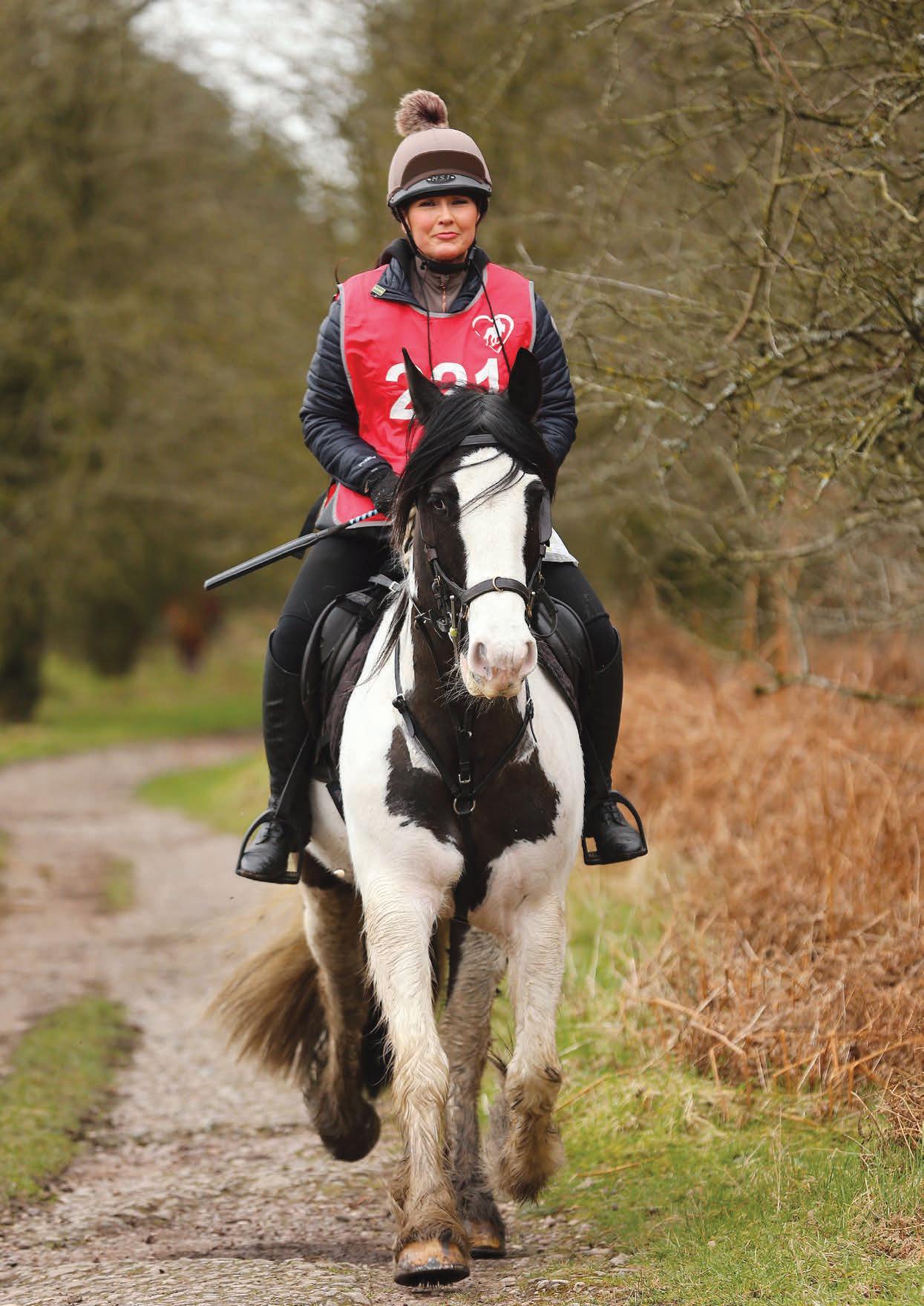
Cobs can!
Meet the chunky superstars excelling in our sport
Ride previews
We take a look at some of the up-and-coming rides
Healthy horses
Ride your way to a happy equine athlete

Spring 24 Official publication for Endurance GB


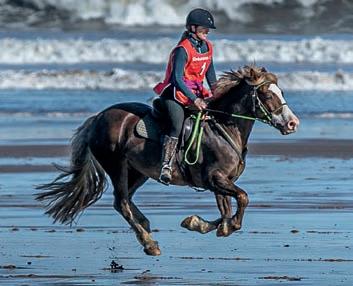
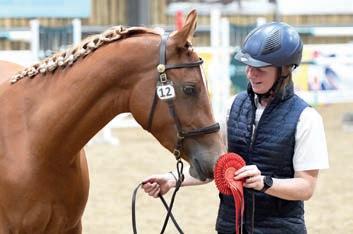

RoR news Our pick of products Vet’s viewpoint From the office Follow us @EnduranceGB EnduranceGB @endurancegbinsta Volume 21 – Issue 1 Endurance GB Office Administration Endurance GB Office, Abbey Park, Stareton, Kenilworth, Warwickshire, CV8 2RP t: 02475 313353 e: enquiries@endurancegb.co.uk Publisher D J Murphy Publishers, Olive Studio, Grange Road, Tilford, Farnham, Surrey GU10 2DQ. t: 01428 601020 Designed by D J Murphy Publishers Ltd Production Editor Nicky Moffatt e: editor@endurancegb.co.uk Advertising Abi Cannon t: 01428 601020 e: abi@djmurphy.co.uk Deadlines Copy Dates to Editor for future issues of Endurance: Summer 24 copy deadline is 20th April. The views and opinions of the writers are not necessarily those of the editor, D J Murphy Publishers Ltd or Endurance GB. Endurance magazine is fully protected by copyright and nothing may be reproduced wholly or in part without the permission of Endurance GB and/or D J Murphy Publishers Ltd. Cover Photo Natalie Hague and Fiddlers Green Freddie competing at Cannock Chase Photo courtesy of David Saunders 16 26 42 ISSN 2516-2349 In this issue Regulars Features 24 22 30 Forthcoming rides Healthy, happy equine athletes Pleasure rides for older endurance horses Interview with Allan Quinney What is success? Breed focus Feeding Meet our survey winner The Phoenix Field Futurity Round-up of our Train for the Terrain series Polka Dot Challenge The Arab Horse Society Premium Scheme 33 6 8 10 12 14 16 18 20 26 28 32 41 Sponsor focus SERC news Young riders Para news Word of mouth 36 34 42 44 46 contents 3
 Nicky Moffatt | Editor of Endurance Magazine
Nicky Moffatt | Editor of Endurance Magazine
Spring is in the air and for us horse owners, that can only mean one thing – more time in the saddle! Here’s hoping the season ahead is a successful one for us all.
In this issue, we meet some of the wonderful cobs who are successfully strutting their stuff in the endurance world. I’m so sorry there wasn’t room for all your lovely images and stories but I was overwhelmed with the response to the social media post, so thank you for getting in touch. Turn to page 16 to find out more.
If you’ve thought about volunteering (and please do, because the sport needs you), discover more about what’s involved on page 12. We interviewed Allan Quinney to hear more about his volunteering roles over the years and maybe his stories will inspire you to give volunteering a go this year, too!
Also in this issue, Maggie Pattinson rounds off our Train for the Terrain series with her thoughts on making the most of your riding time and keeping it fun. You can read Maggie’s great training advice on page 28.
Our 2023 photo competition has now completed and we had a huge number of lovely entries showing what a great season you had across a variety of rides. The judges currently have the difficult task of choosing the top three, who will be announced in the Summer issue. Rosettes will be awarded to the photographer as well as the contributor.
The 2023 Red Gorilla Winter League winners will be announced in the next issue, too. We’ve had a good entry level this year and hope that it
gave you a bit more focus during the Endurance GB competition down time and impetus to get out there in the dreadful weather we’ve had! Congratulations to all who took part in both competitions and good luck. Make sure you get your results to Julie (email: jum1@aber.ac.uk) by midnight on 7 April for processing.
Have fun getting yourself and your horse fit for the coming season and enjoy your magazine.

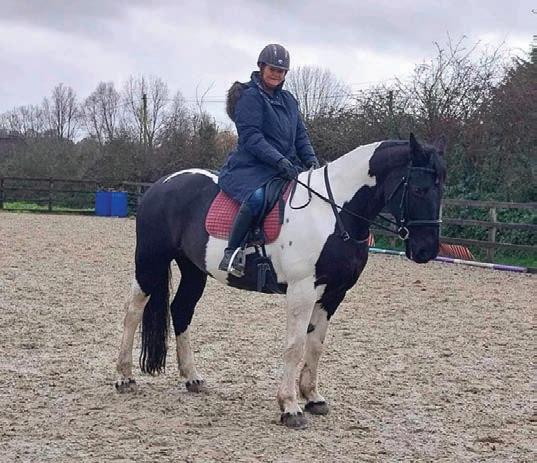
Nicky
welcome | endurancegb.co.uk from the editor 4
A warm welcome
Endurance GB Board of Directors
Chair
PHIL NUNNERLEY
T: 07860 323968 / 01761 221561
E: philnunnerley@endurancegb.co.uk
Vice-chair, Finance & Insurance
CHRIS WRAY
T: 07856 500519 / 01600 860938
E: chriswray@endurancegb.co.uk
H&S & Safeguarding Director
AMANDA WOOLCOMBE
T: 07771 362105
E: amandawoolcombe@endurancegb.co.uk
Welfare & Disciplinary Director
JOHN COLDICOTT
T: 07932 140069
E: johncoldicott@endurancegb.co.uk
Office, International, Para & Sponsorship Director
PHIL NUNNERLEY
T: 07860 323968 / 01761 221561
E: philnunnerley@endurancegb.co.uk
Sustainability Director, Company Secretary & SERC Nominee
ALISON SEGGIE
T: 07860 323968 / 01761 221561
E: philnunnerley@endurancegb.co.uk
PR and Comms Director
HEATHER GILES
T: 07587 098079
E: heathergiles@endurancegb.co.uk
Operations
SHELLEY BATES
T: 07760 264619
E: shelleybates@endurancegb.co.uk
IT, Development & Coaching Director
LARISSA WHILEY
T: 07962 301796
E: larissawhiley@endurancegb.co.uk
Marketing, Groups & Volunteers Director
JIM PHILLIPS
T: 07525 179540
E: jimphillips@endurancegb.co.uk
Directors of Endurance GB are volunteers, so please be patient and considerate with any queries. Most Directors work full time elsewhere and are not always available during working hours. No calls before 9am or after 9pm please.
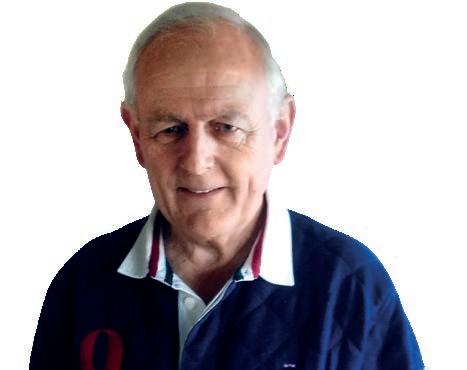
focus Future
Dear Members,
The year 2024 has begun with a deluge of rain and, so far, unusually mild weather. Few of us need reminding of the impact of climate change and the call for a response if we are to save our planet. In conjunction with British Equestrian we will, over the next few months, share and discuss with you all components of our own sustainability strategy.
Horse welfare will always be paramount in our sport. If we are to continue to enjoy the social licence to involve horses in our sport, we all have a responsibility to ensure everyone upholds this priority.
I hope that you’ve been able to get back into the saddle and get your horses (and yourselves) fit for a new ride season. I’d encourage you to set yourselves targets for the year including stepping up to attempt longer distances or upgrading to the next level (horse fitness permitting).
I am encouraged that January year-on-year, our membership numbers are growing again. We have a busy ride programme for the year and my thanks go out to all the ride organisers and their volunteer support teams whose hard work allows us all to enjoy our sport.
In the North and South East we would like to be able to offer more national rides. I’d be delighted to hear from anyone in those areas who, with appropriate support, would be prepared to accept the challenge of organising a national ride.
We have a strengthened Board, but the Directors need support to fulfil the responsibilities attached to their respective portfolios. There is a wide range of committees and if you’re willing to contribute to how our sport is organised, again please let me know.
Good luck with your rides and enjoy the British countryside we are privileged to be able to access. I hope to see many of you out at rides that I am able to attend throughout the year.
Phil
5 future focus | endurancegb.co.uk
Phil Nunnerley | Chair of Endurance GB

Up-coming rides
Bethan Lewis and Charlotte Robinson take a look at some of the forthcoming endurance rides taking place this year
There’s exciting news for Welsh riders with the resurrection of the Welsh Rides Trophies for the 2024 season. These have not been awarded since 2019 and were all but forgotten. By bringing these awards back we feel that it is a great way to encourage more people to enter our beautiful Welsh rides.
The four Welsh endurance groups have come together by donating rosettes and four new perpetual trophies. These will be awarded at the ‘Big Welsh Bash’ at the end of the season (details will be forwarded at a later date).
Only points from Welsh rides will count (including Michaelchurch, which is organised by Offa's Dyke).
The four trophies are:
• The Mynydd trophy for the highest points Welsh rider
• Afon trophy for the highest points Welsh junior/young rider
• Coed trophy for the highest points rider up to 50km
• Cwm trophy for the highest points non Welsh rider
Only the same horse and rider combination to count, not multiple horses by the same rider and vice-versa.
Welsh riders must be a full member of either:
• Mid and North Wales
• South and West Wales
• De Cymru
• Offa’s Dyke
To qualify, you must do three or more Welsh Graded or Competitive Endurance Rides (only two days of Red Dragon to count).
Our rides this season are:
• Wentwood 24 February
• Talybont 31 March
• Pembrey 20-21 April
• Clocaenog 26 May
• Wye Valley 23 June
• Elan Valley 25 August
• Michaelchurch 8 September
• Red Dragon 27-29 September
• Wentwood 20 October
So, get your entries in on Endurance GB Clubhouse for a chance to be awarded a fancy new Welsh Rider trophy for 2024.

features | endurancegb.co.uk
Ride previews ride previews
Photo: David Saunders
6
Fiona Valentine and Arranberg Mai at Elan Valley
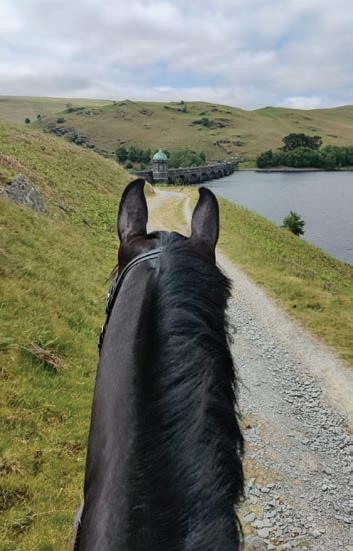
Ride the Wight
The popular Ride the Wight equestrian event is back for 2024. Organised by the Mid-South group, this two-day riding event will take place from 15-16 June in the scenic West Wight area.
After a successful 2022 ride at Kingates Equestrian in Niton, the organisers have decided to move the event to new trails in West Wight. This gives riders a chance to explore new bridleways, forests and byways across the Isle of Wight’s expansive network of trails. The routes will take in some of the most beautiful areas of the island.
The venue is flexible in order to allow riders to arrive a few days earlier or extend their stay for a few extra days. This provides the option to make a social weekend or mini-break out of the event, and experience more of what the island has to offer.
A key feature is that there are no repeated trails on the first 40km route. This enables

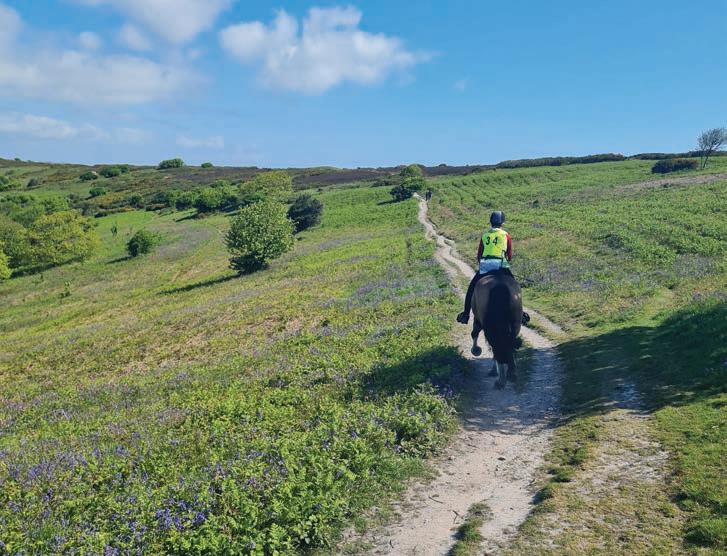
riders to experience new scenery throughout the longer ride. The routes also minimise roadwork, focusing on the island’s scenic offroad bridleways.
The ride will be supported by Raynet volunteers, providing communications assistance and support at the checkpoints along the way, to ensure a safe and well-coordinated event.
There are ride options for all levels. Shorter distances of 16km, 25km, and 33km are available. For more experienced riders, longer routes go up to 80km on Saturday. Sunday offers rides up to 40km.
For those riding the full weekend, there are multi-day classes ranging from 65km-120km. The multi-day rides allow riders to fully immerse themselves in the Isle of Wight’s beautiful scenery over two days of riding.
Riders will traverse the open downs of Brightstone Down, Westover Down, and Compton Down, with sweeping views over Compton Bay and the English Channel. The trail continues inland past historic thatched cottages to the quaint village of Freshwater.
Another highlight is the panoramic views from the viewpoint at Limerstone Down. This vantage point overlooks the western-most point of the island. The trail also winds past the ancient Carisbrooke Castle, originally built by the Romans.
The new venue offers stabling, corrals, camping facilities, catering, water, and toilets on site. There are also several smaller yards in the area offering stable accommodation for riders. For those not wishing to camp, there are holiday lets, B&Bs and hotels nearby.
The ferry ride can be part of the fun and adventure. The horses are absolutely fine on the
ferry and the crew are very helpful in looking after equine passengers.
The ferry companies offer discounts for horses travelling to the event. Riders with lorries should consider routes via Southampton and Lymington to avoid the new clean air charges in Portsmouth.
For those making a long weekend of the event, there are plenty of attractions and activities on the Isle of Wight. The Gin & Steam event takes place from 15-16 June at the Isle of Wight Steam Railway. Visitors can ride the vintage steam trains while sampling different varieties of gin.
The famous Round the Island Yacht Race also occurs on 15 June. The week before and after will be a great time for spectators to enjoy the maritime festivities and pageantry in Cowes.
Animal lovers can visit the Isle of Wight Donkey Sanctuary to see the adorable rescued donkeys. The Ventnor Botanic Gardens offer gorgeous grounds and rare tropical plants and outdoorsy types can hike along the miles of scenic coastal paths.
Culture vultures will enjoy Osborne House, Queen Victoria’s magnificent seaside palace. Carisbrooke Castle has centuries of intriguing history. For unwinding, visitors can head to the beach for swimming, sunbathing, seaside walks, or just enjoying ocean views and the island’s natural beauty.
If you have any questions, contact the organiser Karen Whittington, who lives on the island. Tel: 07854 609107 or email: karenandrobert2008@hotmail.co.uk.
Dust off your riding boots and make plans to Ride the Wight in 2024. Don’t miss out on this memorable Isle of Wight experience!
Are you ready to ride the Wight this season? Kayleigh Tonkins and Teifi at Elan Valley
ride previews 7
Ride the Wight is mostly bridleway tracks

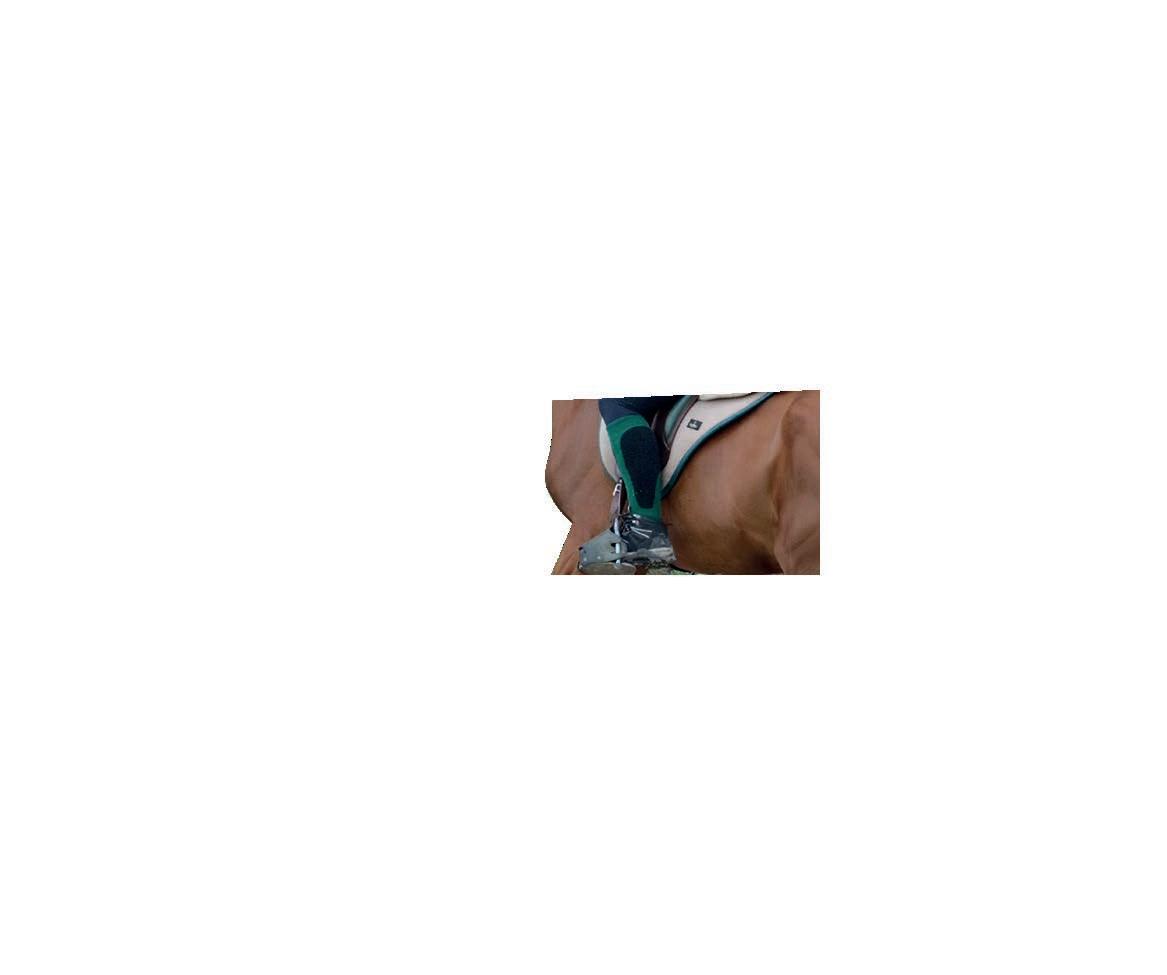
Esther Groen discusses tried-and-tested techniques to keep your endurance horse sound, happy and healthy in his training
About Esther
Esther runs Groen Equestrian –endurance coaching. Visit her website: www.groenequestrian.co.uk for more information.
I’m thrilled to write another four articles for you and if you missed the previous ones – Fuel efficiency, How to gauge the efforts of our horse in work, Using your heart rate monitor when training and The fitness plateau, have a look at the blog pages of the Groen Equestrian website.
In this series, we’ll look into the quality side of training and how to have a healthy, sound and happy equine athlete. As important as getting our miles in, the way we do those miles is as important, perhaps even more. It is very much a
different type of training we want for skills (the more gymnastic/dressage side or riding) versus training for stamina and fitness.
Incorporating skills into your stamina (quality into the quantity) will give you a healthier horse. When we’ve established a good, healthy baseline in our horses’ way of going, they will revert to that, even when getting tired.
However, if we let our horses go on the forehand for all those miles or let them load one leg more than the others, the long-term effect will be increased wear and tear which can result in repetitive strain injuries or the onset of degenerative joint disease.
Many of us love to ride out and prefer not to have to fuss or think too much, but I hope these articles will inspire you to incorporate simple checks to improve your horse’s way of going, and hopefully that will become a new habit.
Looking after legs
An example of how the quality of your riding can improve the longevity of your endurance horses is when riding on hard ground or better, how you ride your horse on hard ground. We must all do some road work or ride on gravel tracks and in

summer the ground can become hard, so some hard ground really is inevitable.
We’ve all heard the studies that tell us about the potential risk to our horses' legs trotting on hard ground but often there's no getting around it. And yes, trotting on hard ground does give concussion in the legs, but it very much depends how you trot on the roads. Do you just let your horse go as he wants or are you asking him to accept a contact and round the back a little? When we ask the horse to use his back, we reduce the impact of the feet on the ground dramatically.
You can hear this clearly by the sound of the feet on the ground. If you let your horse go on the forehand or hollow his back, the
8 features | endurancegb.co.uk training
sound increases quite a bit and with that, the concussion in feet and limbs builds up.
Looking after legs
If a horse is also a little asymmetric (as we all know they are) or the rider is a little crooked (and, again, most of us are), we make this concussion worse, especially on the leg the horse is loading more or the side we lean to more. So this would be my next tip to keep an eye on –riding and sitting straight.
This isn’t always easy as many of us train on our own and our bodies have a way of tricking us. We feel we’re straight, but we are probably not, and the same applies for how we feel about our horse. What feels normal is not always the right balance.
So, check with your coach/instructor or if you ride with others, ask them to tell you what they see so you can become more aware of whether what you feel is a correct balance for you and your horse, or whether you need to start adjusting your habits.
The basic foundation: six steps of riding ‘in the box’
I follow a step-wise strategy in my teaching. The steps have a logical progression, build one upon the other in turn, and link together in many ways.
Each step is a prerequisite for the next one. For example, without energy, you can’t take up a proper contact, without contact, you cannot create flexion. All these steps together are part of riding which I then feed into the concept of riding ‘in the box’ when I’m teaching.
This imaginary box is where the horse travels and the rider can use it to check if all the foundations of energy, contact, flexion, straightness, balance and obedience are in good working order.
When the horse is working in the box, the rider should not have to correct or ask much. The horse will have a relative sense of freedom to do as he pleases, if he stays within the
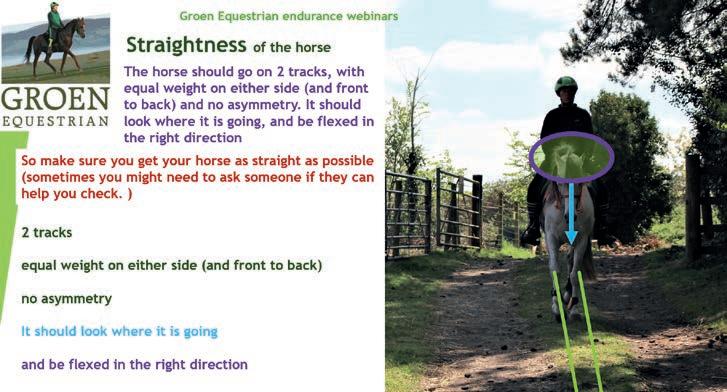
boundaries of the box. When a new exercise is commenced, the rider should find that they need only to give minor aids to make any changes to ‘the box’.
So, let’s go over these different parts of riding in that box one by one.
1. Energy. Energy allows you to work and powers the engine. The engine is in the horse's hindquarters, and we need to channel it forward (not hold it back which often happens). We need a horse who's willing to go forward on small aids. Not only do we have to give the correct aids, but we must ensure that we don’t contradict them, for instance by asking the horse to go forward with the leg but at the same time holding back with the reins.
2. Contact. The reins are our most direct way of communicating with the horse, but they can also interfere with the horse's way of going a lot. Many riders ‘shout’ to their horses. There should be give in the contact allowing the horse to always move freely forward. Hand, wrist, and arms should hold or yield to some extent and no pulling back. A good contact will give a direct line from your elbow to the horse’s mouth.

3. Flexion. The horse needs to look where he’s going and bend accordingly. To do this we need to flex the poll in the correct direction. The poll should be in a neutral, soft and yielding position, responsive to our question of right or left flexion. Many horses are asymmetrical and automatically flexed one way, making the opposite turn harder. A soft jaw means softer shoulders, a softer back and better use of the hindquarters.
4. Straightness. Without the previous three steps we’ll struggle to straighten our horse. We need energy to go forward, the contact to communicate and the flexion to ask for the straightness. A straight horse will move on two tracks, on a straight line as well as when bending on a circle. Most horses are not straight, nor are we. We all have a favoured side and a weaker side.
5. Balance. Balance is both back to front and left to right. In the wild this would serve a purpose. A favoured hindleg to run away faster, and being on the forehand will also help with the initial acceleration (hence human sprinter athletes start leaning forward in the starting blocks). But, as a competition horse, a more balanced horse will reduce too much strain on limbs and back. Aim for a horse who can lift the breastbone and trot and canter on both reins equally well. A good rider balance is crucial for this as our lack of balance will influence that of our horse greatly, as we are levered on top.
6. Obedience. A responsive horse will react to corrective aids without a fight, and we can go faster, slower, around bends or anything else we require to do easily. To do this, we need to have mastered the previous steps, make sure we ‘speak’ the same language and both understand which question requires what answer (and that is sometimes more difficult than we think).
My next article will discuss improving our horse’s balance and gaits during training.
9 training
Pleasure Rides Endurance GB

Jane Stewart tells us more about Harry, a 27-year-old pony who’s excelling in Pleasure Rides
Harry’s a 27-year-old ex-Pony Club jumping pony who I’ve had on permanent loan for about six years. He’s used for hacking and as a field and training buddy for my endurance equines, but has never done a vetted endurance ride –partly because my arms weren’t strong enough to hold him in fast company!
In the last 18 months, Harry’s become ‘creaky’ in his flatwork lessons and his left canter had become four-time. He didn’t have quite as much va-va voom on his usual hacks on the local country lanes but still loved a good gallop on grass.
Rather ominously, his professionally fitted saddle was slipping badly to the left and Harry was drifting right. On investigation, he was sound on a straight line trot up but uneven when lunged in a small circle to the left, and he
failed flexion tests on his left hind. Like many horses of his age, he was showing signs of low grade arthritis in his left hock.
Despite medical intervention and reshimming of his Wintec adjustable VSD saddle by a master saddler, his saddle

continued to slip to the extent that it was becoming awkward to ride him. However, Harry was still keen to go out to places (he’s one of those self-loading ponies who is always looking for his next adventure) and it seemed wrong to retire such an active pony.
What next?
As a last resort, in summer 2023, I switched Harry into a Free 'n' Easy saddle that had belonged to a sadly departed Advanced grade endurance horse.
Free 'n' Easy Saddles have very long panels –reminscent of an old cavalry saddle – but unlike a cavalry saddle with solid panels, the Free and Easy panels have flexible fins that are designed to move with the horse.
The outcome was amazing. This saddle didn’t slip and, as a result, Harry was no longer drifting to the right. Even without any medication, Harry was sound and back to being Happy Harry. He had a great time jumping at a hunt fun ride in early Sept 2023.
Pleasure rides
Harry’s Free 'n' Easy Saddle made a huge difference to his performance
Photo: Chris Cole West End Photography
Harry at Lion's Tail Pleasure Ride
10 features | endurancegb.co.uk pleasure rides
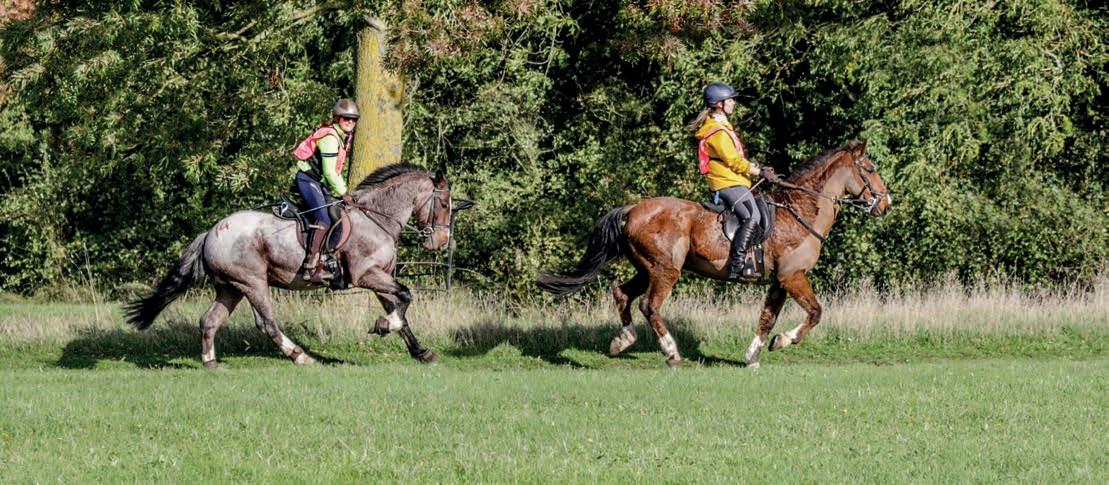
Happy end to the season
In spring 2023, I bought a seven-year-old gelding called Bilbo, who had never done any Endurance GB rides. I started doing Pleasure Rides fairly close to our Cheshire home but also wanted to travel further away. I didn’t want Bilbo to be stressed by the longer journeys and knew that having Harry with him would be a fabulous stress buster.
So now that Harry was sound without medication, Bilbo and Harry were booked into a couple of vetted Pleasure Rides at the end of the season – the Lion’s Tail ride in September in Leicestershire then Concrete Cows ride in October in Milton Keynes.
These rides were chosen to suit elderly Harry based on three criteria:
1. The vettings would be on grass and not on tarmac or hardcore.
2. Neither route had much riding on tarmac.
3. Neither route had serious hills.
Harry’s one of those ponies who can go first or last but much prefers to go first! He powered around the wonderful grass headlands of Lion’s Tail then led newbie Bilbo through all the slightly bonkers stuff that is on the Concrete Cows route (not least, of course, those freshly painted concrete cows!).
One of the joys of Endurance GB Pleasure Rides is there’s no speed pressure. We stopped to let bemused Milton Keynes’ locals pat the ponies or have their photos taken next to us.
When Harry was vetted at the end of his Milton Keynes ride circa 30 minutes after the photo was taken, the vet advised that he was a bit short on his left hind for the first few strides but then became level – nothing to be too worried about for a 27-year-old pony! A happy ending to a great day.
Older horses and Pleasure Rides
Obviously, keeping an older horse ‘on the road’ requires some accommodation for age. I’m lucky to have plenty of well-drained land and Harry and Bilbo live out all year round. Harry’s never stuck in a stable getting stiff which is probably the most important thing to help extend the riding life of an older hose. I was also lucky to have a spare endurance saddle with its long
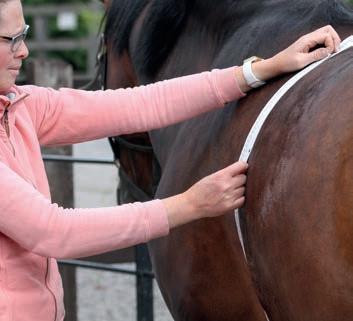
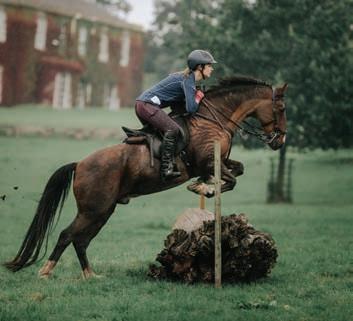
flexible panels. However, here are some other suggestions for older horses…
• Be rigorous about weight control. Harry’s on controlled grazing from April through to autumn
• Accept that your horse has age-related assymetry and ride in a manner which keeps the horse more comfortable. For example, ride on their ‘good’ diagonal when you’re on straight lines rather than changing diagonals every few minutes – for Harry that’s his left diagonal when his right hind strikes the ground
• Allow your older horse to canter on whichever leg they wish
• Slow down for corners and re-balance. Never expect older horses to trot or canter on tight turns or trot down hills
• Keep feet well trimmed/shod. Just because an older horse is getting less work than a horse doing graded endurance rides, it’s still important to maintain a regular schedule. Harry’s on a six-week schedule.
Future plans
Harry loves jumping but due to his left hind leg arthritis, he isn’t happy jumping then doing tight left turns to the next fence. We’ve abandoned schooling – maintaining symmetrical flexibility on both reins isn’t realistic anymore.
In my opinion, Endurance GB Pleasure Rides are perfect for older horses – mostly straight lines, mainly off road, helpful stewards and vets in a lovely location – what’s not to like?
Your golden oldie may seem a bit jaded when hacking around their usual routes at home but just watch them become reinvigorated at a new location, strutting their stuff and showing the youngsters how it should be done! What does 2024 hold? Maybe more Pleasure Ride rosettes for 28-year-old Harry!
Harry leading Bilbo at Concrete Cows 2023
Photography: Something from the Hart, Piaffe Photography/Shutterstock.com
Photo: Ruth Saunby, IndiePics
11 pleasure rides
Harry jumping at Hales Estate Fun Ride, September 2023
Allan Quinney Interview with

We talk to Allan to find out more about what’s involved in becoming a volunteer
1.How did the volunteering start?
Back in 1985, I was a member of the Trail Riders Fellowship (TRF). At one of our meetings we were asked if we’d like to help with marking out a route for an endurance ride. The first ride that I helped at was Three Rivers, when it ran from Salisbury Racecourse. I started off with route-marking, which progressed to route checking and marshalling. I even took a vet out on the back of my bike once, to attend to a horse needing treatment in an otherwise inaccessible part of the route.
2. What are your main roles?
Since leaving the TRF I've helped with radio communication on course as a member of both Raynet and Revcom. I also volunteer to help on water points, road crossings, venue set-up and route marking and I’ve been parking steward for most of the Wessex rides and air traffic control at the glider field on the Bonham ride! I’m happy to get involved with anything that needs doing.
Allan’s top tip
Don’t be afraid to ask questions. Most people will be more than happy to help and will be grateful you’ve given up your time to volunteer.
3. What are the highs and lows of the job?
The most fun part of volunteering is getting out on course, seeing the horses come through, enjoying lovely views of the countryside and visiting places I wouldn’t normally go to. As well as helping in my local area of Wessex, I have been to rides in Kent, Cornwall, mid-Wales and many other places in between.
I also used to love leading the horses out at the start of the competitive endurance rides (CERs) at Salisbury Racecourse. CERs used to start in the dark and the TRF escorted them along the first section of road work.
Some jobs can be a little more stressful than others. I was steward at a very busy checkpoint at Cirencester a couple of years ago. Horses were coming through my checkpoint numerous
features | endurancegb.co.uk
Interview interview 12

Allan’s top tip
Be prepared to help with whatever is needed if you can. Sometimes things don’t run smoothly and ride organisers may need to change plans.
times from three different directions. I logged over 400 numbers on the Saturday.
On the flip side, I once drove a 200-mile round trip to steward a gate that only four horses came through during the entire day.
Least fun parts of volunteering are the early starts (I got up at 4.30am to help Claire with the Snowdrop Ride recently) and also being out in the rain all day.
4. How would someone who doesn’t know where to start get involved?
Contact the organiser of a local ride or a committee member and explain that you would
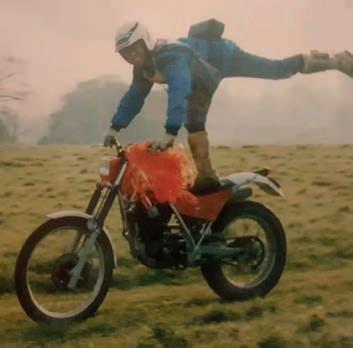
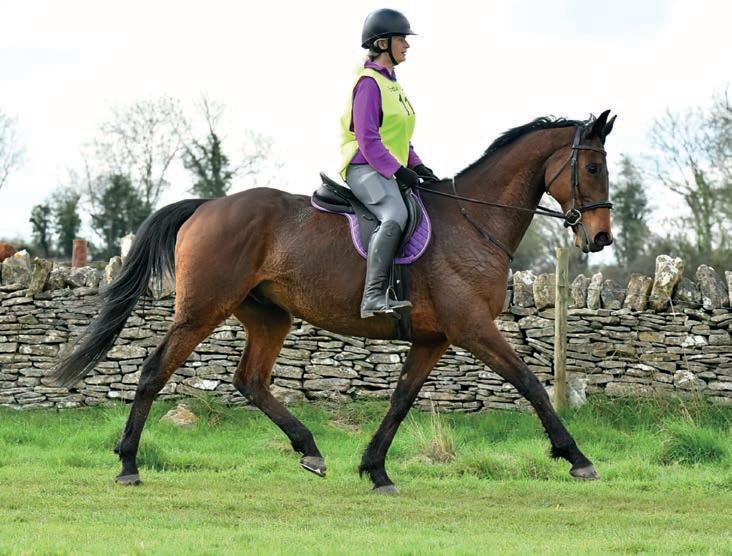
like to get involved. Explain to them that you haven’t helped out before and they will find a suitable job for you. There’s always something to do and most jobs don’t need any previous experience.
5. Tell us about your volunteering duties over the years.
After 38 years of volunteering I still look forward to helping out at the usual rides as well as looking forward to new rides that I haven’t been to yet.
I’ve made many good friends through volunteering at endurance rides and even managed to meet my wife, Claire! I first met Claire at one of the Salisbury rides when I was still in the TRF and we got married in 2018.
I was lucky enough to be asked to help crew Team GB (Liz Finney, Joy Loyla, Lilla Wall and Judith Heeley) when they won team gold at the World Equestrian Games in Sweden in 1990. It was an amazing experience that I never would

“I've made many good friends through volunteering at endurance rides and even met my wife Claire"
have been offered if I hadn’t got to know people through volunteering.
6. What would you say to anyone else thinking of volunteering?
Volunteering is a great way to make friends, spend time outdoors and do something worthwhile and rewarding. Of course, there’s aways the added bonus of a bacon sandwich back at the venue once you’ve finished your duties for the day.
7. What sort of person makes a good volunteer?
Someone who enjoys being helpful and is prepared to give up a little of their time to help others or to put something back into a sport that they already participate in. Rides simply wouldn’t happen without volunteers. Volunteering would also appeal to someone who’s prepared to learn something new.
Allan's wife Claire on her ex-racer Boycie
Escorting Claire and Bea on a ride
Showing off his biking skills at a ride
interview 13
Allan's happy to help with anything
Training

A long time endurance member helps you discover your ‘happy place’ with your horse
I’m in no doubt that most readers will immediately say ‘my happy place is with my horse’, but in what context? And what do we mean by happy place?
• Wellness made easy?
• Quiet contentment?
• Freedom from angst?
• No questions asked, no answers offered?
• Time and space to be ‘in harmony’ with your horse?
• A smile that comes from the inside?
The joys of endurance
Endurance, where long hours of quality time are shared with your horse, often in the company of like-minded people (who you may not otherwise have met), probably has the greatest potential of all equestrian disciplines to provide and expand horse-related wellbeing. And when your nearest and dearest are involved in supporting you by crewing at the venue and out on course, this happiness is shared with your family too.
Your happy place

It’s true to say that individuals’ expectations and contexts of happiness will vary widely, maybe depending on what life is currently throwing at them, but perhaps getting away from the day-today grind and life’s problems will be enough to find horsey mind rest and relaxation?
Your favourite ride
Young people are often the easiest to please. Teenagers, with or without their own horse/ pony, are likely to be overjoyed with any opportunity to be in the company of equines (mucking out, tack cleaning, grooming, leading out or, if they’re lucky, riding). But once ‘caught
by the endurance bug’ they can also become incredibly competitive – you’ve been warned!
Over the years newcomers to the sport have often asked me, “Which is your favourite Endurance GB ride?” – an impossible question to answer because personally I love them all!
Your favourite ride will undoubtedly not be the one ridden in torrential rain, when your horse pulls your arms out, or doesn’t want to go on, or if you pull a shoe or your horse goes lame. But what doesn’t suit one horse and rider combination may be just the job for another.
Overlaid on this is how fit you and your horse are – not enough fitness and you may both suffer. Where you live and how you train will affect your ability to cope with challenging terrain. The wise rider prepares well and monitors how their horse is feeling and rides accordingly, reducing the distance of the class, if necessary, when the going will be outside your comfort zone.
Good preparation also involves reading the ride information and trying to avoid a first time experience at a ride – for me it was high speed railway lines and bridges over a busy motorway which were totally unknown to my rural novice horse. Hilly rides are often rewarded by the magnificent panoramas that come into view once
Photos: mariait/Shutterstock.com, coxy58/Shutterstock.com, Leszek Glasner/Shutterstock.com
14 features | endurancegb.co.uk training

you have reached the summit of the hill. But then there’s always the descents which can be equally demanding on fitness.
Finding your happy place
Obviously when the sun shines and your horse behaves impeccably, there’s no finer place to be than on the back of a horse. But ‘happy place’ may not be confined to ride days. It can be the lovely hack on your favourite horse on a beautiful day or (with the right clothing) having the world to yourself when everyone else is tucked indoors.
For other horse riders it may be completing a near-perfect dressage test or a clear round of showjumping. Endurance has its pinnacles for some to aspire to, like winning the Red Dragon or being part of a winning team (Group or Home International).
But to begin with, it may be enough to successfully box and travel from your livery to a venue and negotiate the vetting and the start – all with unknown horses around you.
Of course, practice makes perfect, and as the unfamiliar becomes commonplace and the norm, you and your horse don’t even give it a second thought. Initially it may seem a very big step for many riders, with little or no opportunity to ride out, to box to a ride. Initially daunted, they’ll be so proud of themselves to find their ‘happy place’ when all goes well.
I would suggest that the unique selling point (USP) of riding with Endurance GB compared to locally organised fun rides is from the shortest Endurance GB Pleasure Ride through to a oneday 100-milers (160km) all riders can be assured that the Ride Organiser has put together the best possible and safest route.
Endurance GB culture requires all riders to be considerate to ensure the safety and pleasure of others. And Ride Organisers plan their routes and timings in order to avoid putting inexperienced horses and riders under pressure from the highly competitive.
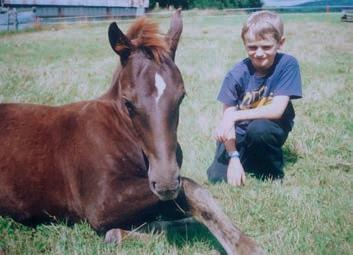

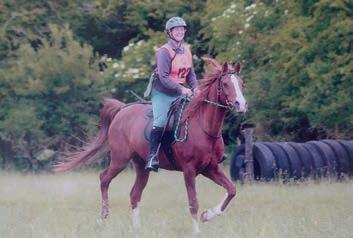
My own experiences
My happy place will always involve harmony between horse and rider (the feeling of effortlessly going with one mind), and always off-road (away from delivery vans, lorries and tractors) in wonderful countryside. Usually we will be going at our ‘minimal effort’, free-flowing
“Obviously, when the sun shines and your horse behaves impeccably, there's no finer place to be than on the back of a horse."
trot or a rolling canter with maybe a short burst of gallop. And over the years Endurance GB has offered me these opportunities in spades.
The images (pictured left) illustrate our family thoughts on ‘happy place’ with three family images over more than 30 years.
And then sharing an article I wrote:
“Wow, wow and wow! The sun shone, the sea sparkled, the grass was green, the lambs frolicked and, luckily for us riders, the gate stewards were ever-present and smiling.
The revised 25km route took in the best of what’s available in this part of Dorset. The tracks appeared largely unridden by the locals, so the going was grea and my mare and I had a blast.
Originally having entered the 25km Pleasure Ride to chaperone our new boy, we decided he wasn’t quite ready for it, but Angel and I would still go to have fun. Meanwhile my husband took our dogs a lovely walk. Win, win.
Having injured my back the previous August, followed by months of recuperation, then Covid, it was the furthest I’d ridden for nearly six months. We had no game plan, just questions unanswered. My mare wasn't ride fit and I didn’t know how my body would cope. Did I need to worry? No. All the joy came streaming back, Angel slotted into her easy endurance trot and canter and was more than happy to lead a new horse/rider doing their first Graded Ride together. Being a dinosaur, we have no riding apps, only a time clock in our head to refer to. We work on the principle of trot and canter where we can and walk on downhill roads that might be slippery or tracks that are too stoney.
Back at the venue it seemed strange to say 'only a Pleasure Ride' to the vet. There was definitely something missing without the heart rate check and the chat with the vet about how the ride had gone. But our speed was respectable, which bodes well for the rest of the season. A happy place that went on all day long.
May you find your happy place, too. training
Years later, proof of successful recovery after injury
Fabulous weather and route and my first Grade One on a much-loved novice
15
Our young son with a baby horse having her Siesta
Cobs can
Meet some of the wonderful cobs taking part in our sport. It appears they come in all shapes and sizes
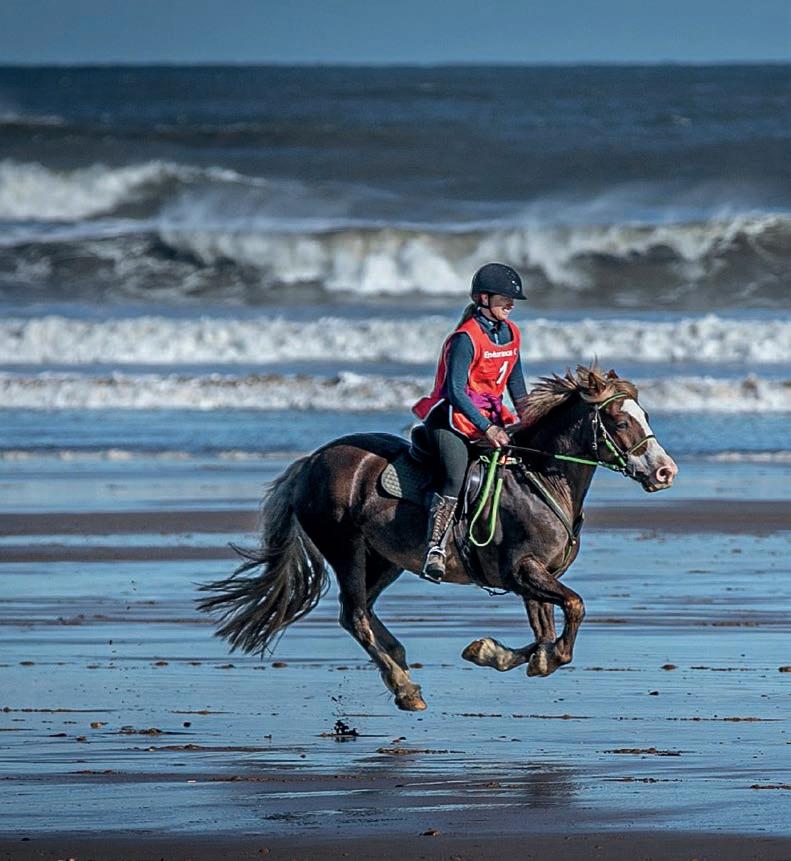

Riders: Samantha Woodhead and Zoe Buchanan
Horses: Indi and John Lad
Ride: Stanage Edge
Photographer: CJ Barrett
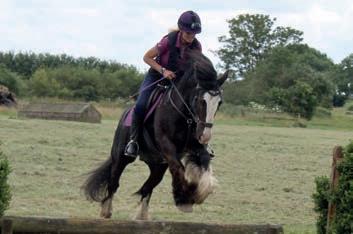
Rider: Heather Leavis
Horse: Bascote Alexander, aka Alexander
Ride: Out on a hack
Photographer: Tess Cadman
Rider: Abygail Frazer
Horse: Archie
Ride: Seal Sands Durham & Teeside Group
Photographer: Andrew Ray
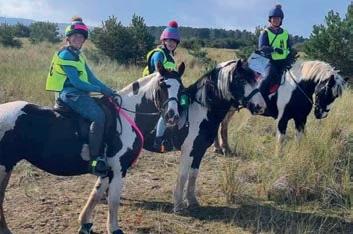
Riders: Fiona MacGregor, Abi Cox and Kerry Cartwright
Horses: Mia, Danny and Marshall
Ride: Tentsmuir Photographer: Jackie Taylor
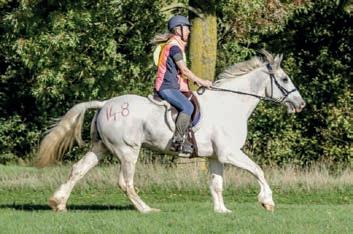
Rider: Lisa Whitehouse
Horse: Shamrock
Ride: Concrete Cows
Photographer: IndiePics

Rider: Claire Mellor
Horse: Queen of Hearts, aka Rosie
Ride: Tinsel Trail
Photographer: Andrew Ray
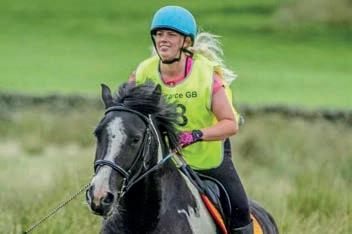
Rider: Emma Luke-Ward
Horse: George Benson
Ride: Durham Group
Photographer: Andrew Ray
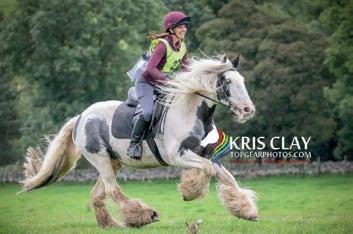
Rider: Vicki Shanks
Horse: Billy
Ride: Kirkton Manor
Photographer: Kris Clay, TopGearPhotos.com
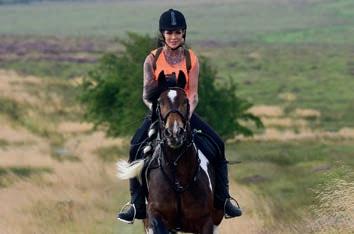
Rider: Paige Harrison
Horse: Tally
Ride: Barbrook
Photographer: Jem Photography
features | endurancegb.co.uk breed focus
Breed focus
16

Rider: Tahnee Burgess
Horse: Normoss the Duke
Ride: Cropton Forest 32km
Photographer: Andrew Ray
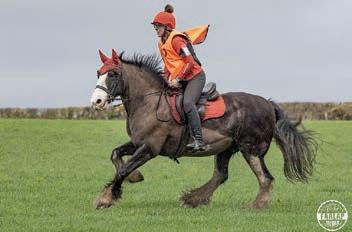
Rider: Jamie Barker
Horse: Jake
Ride: Wadebridge
Photographer: Farlap Photography
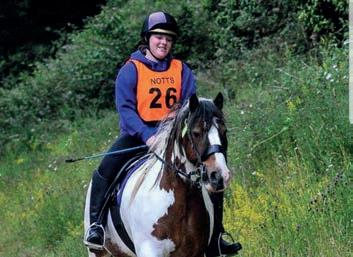
Rider: Kerrie Baker
Horse: Tommy
Ride: Cresswell Crags
Photographer: West End Photography

Rider: Emily Hammond
Horse: Disney
Ride: Luffenhall
Photographer: Photography by Jamie

Rider: Norma Thompson
Horse: Kissie
Ride: Dialstone
Photographer: Marimages

Rider: Lynn Raistrick
Horse: Rosie
Ride: Titlington
Photographer: MPG Photography

Rider: Sharon Halafu-Booth
Horse: Dillon
Ride: Manifold
Photographer: Matthew Turner

Rider: Michelle Watts
Horse: Blue Bear
Ride: Wessex Snowdrop
Photographer: True to You Photography
breed focus 17
Feeding good doers
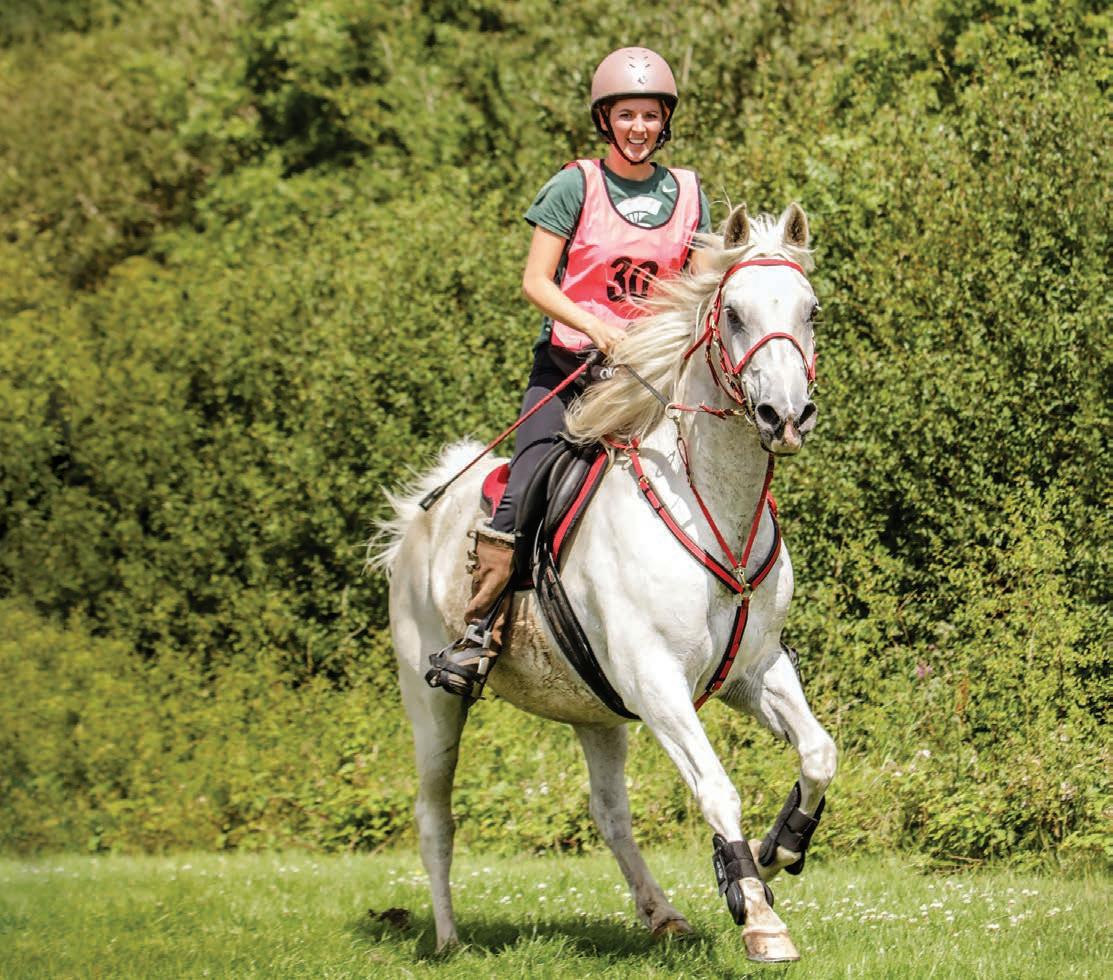
Endurance horses and ponies come in all shapes and sizes and it is important to treat each animal as an individual and feed according to their own specific needs. Of course, you should always consider factors such as age, breed, workload, how well they hold their weight, grazing quality and any health issues that may affect their feeding requirements, but what else do you need to think about when supplying your horse with everything he needs?
Weight watching
One of the most important aims when feeding all equines is to keep them at an ideal body condition and prevent obesity, which in turn reduces the risk of developing many serious health issues including laminitis. Carrying excess weight will affect an endurance horse’s ability to perform at his best and place additional strain on legs and joints, which can lead to lameness.
Conditions that arise from a horse being overweight can be costly to treat, and often require long-term management as well as negatively affecting the animal’s way of life and ability to be ridden. Prevention is most definitely better than cure!
Just like any other animal, horses become overweight when their energy intake from feed exceeds their energy needs for growth, maintenance and work/exercise.
Cobs and native breeds of horses and ponies are particularly at risk of becoming overweight as they have evolved to thrive in their natural habitats where poor grazing, harsh weather conditions and the ability to roam over large areas all help prevent excess weight gain.
According to the British Horse Society, it’s estimated that up to 50% of our domesticated equines in the UK are overweight or obese, and when limited to just native pony breeds, the figure could be as high as 70%. Our horses and ponies are often grazing pastures that are sown and fertilised specifically for rearing farm animals and this is likely to provide a much higher energy/calorie level than most horses require.
Regularly using a weigh tape and body condition scoring your horse is an ideal way of keeping track of his condition, allowing you to make necessary adjustments to the diet and routine to prevent excess weight gain.
A low-calorie diet
Every horse and pony should be fed according to the amount of work they do – too much feed or one which exceeds their energy requirements is likely to lead to weight gain or over-exuberant behaviour! Be careful not to over-estimate how much work they are doing. It’s unlikely that any endurance horse in the early days of a fittening programme or competing at a low level will be in any more than a light level of work, similar to that of any pleasure horse doing hacking and light schooling.
While many horses can meet or exceed their daily calorie needs from grass alone in summer and supplementary hay in winter, a forage only diet is unlikely to supply enough vitamins and minerals to provide a balanced diet.
Alongside grazing and hay, feeding a very low-calorie (8MJ/kg or less) balanced bucket
Joanna Palmer, nutritionist for Allen & Page, offers advice on feeding endurance horses and ponies who are good doers
Feeding 18 feeding features | endurancegb.co.uk
feed at the minimum recommended amount for the horse’s size and workload will provide good doers with all the essential nutrients they need, without too many additional calories. Fast Fibre is an ideal feed for good doers as it’s low in calories but fully balanced with vitamins and minerals. As it contains no whole cereal grains or molasses, Fast Fibre has very low starch and sugar levels that make it suitable for horses and ponies prone to laminitis.
Meeting additional energy requirements
For horses in more than light work and competing at longer endurance rides, you may need to increase the energy content of their diet to fuel their increasing workload. Harder working horses also require more quality protein to support muscle growth and repair.
It’s particularly important to remember that calories are a unit of energy, and it is not possible to feed a horse a higher-energy diet to fuel their workload without risking them putting on weight, unless those extra calories are used up through exercise.
Before increasing your horse’s energy intake ensure he’s at an ideal body condition score and that his increased workload is sustainable. Stepping up from a low-energy feed to a medium-energy one is ideal for harder working horses but must come with paying close attention to assessing weight and condition to ensure that the additional calories are being used up through exercise and not contributing to weight gain.
Alternatively, continuing to feed a low-calorie base diet and then adding a small amount of a very high-energy feed will provide a controlled boost of energy that can be increased and decreased as necessary to help prevent unwanted weight gain.

Restricting grass intake
Unrestricted access to good grazing will lead to significant weight gain in most horses and ponies, as they often do not regulate intake, consuming up to 5% of their bodyweight per day! The high sugar level this grazing provides is also a major risk factor for developing laminitis and for this reason lush, fertilised grazing should be avoided for all good doers.
Unproductive, poor-quality grazing is best for horses likely to gain weight easily and those at risk of laminitis. To promote weight loss in good doers and overweight horses, it’s important to reduce energy intake so they are eating fewer calories than they are using up through body maintenance and exercise.
It’s important not to restrict the amount of time a horse is turned out to ensure they can exhibit their natural grazing behaviour and move freely, burning some of those excess calories. We do need to restrict the amount of grass they can access while turned out, therefore using management techniques such as strip grazing, a grazing muzzle or a track system will all help to reduce the calories they consume.
It can be tempting to be very strict when feeding an overweight horse or pony, but
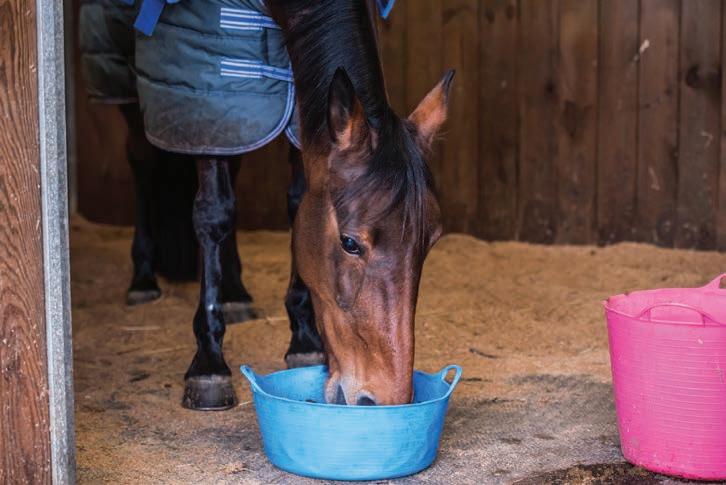
they shouldn’t be starved as this can cause serious health problems and boredom-related behavioural issues.
Horses have evolved as trickle feeders and their digestive systems require an almost constant supply of fibre to work efficiently and maintain digestive health. When stabled or on very restricted grazing, an alternative source of fibre such as low-energy hay or hay that’s been soaked for up to 12 hours in as much fresh, clean water as possible to reduce its sugar content is a good idea.
Using small holed haynets and splitting the daily hay allowance into several smaller meals throughout the day will extend feeding time and avoid lengthy periods without food.
Ideally, good doers will naturally lose weight during the winter when temperatures are lower and quality of grazing is reduced. Any extra calories a horse uses up to keep warm will aid weight loss, so only rug your horse when it's absolutely necessary.
Even for horses who come out of winter at or just below an ideal body condition, a weight control programme should be implemented in very early spring, as the first flush of spring grass can lead to rapid weight gain unless measures are in place early in the season and maintained throughout the year.
Exercise
Restricted grazing and a balanced feed with an appropriate energy level should be combined with exercise to encourage weight loss or prevent unwanted weight gain. Encouraging a horse to move around in the field by creating a track grazing system can help to increase activity levels and burn calories. Any increase in ridden exercise will use more calories, so stepping up to longer distance rides will help good doers maintain an ideal body condition.
Research has shown that a horse will be in an optimum fat burn zone during trot, so utilising this pace and incorporating hill work can really help shift the excess weight. Ensure any increase in exercise is carried out gradually as this will help prevent injury and build up sustainable fitness safely.
By restricting grass intake and maintaining a high-fibre diet alongside a suitable balanced bucket feed, the nutritional needs of good doers of all ages can be easily met. When combined with appropriate exercise and regular assessments of weight and condition, a balanced diet will help keep horses at ideal bodyweights.
For more information
For more information on feeding your horses and ponies visit: www. allenandpage.co.uk or call their friendly nutrition helpline on 01362 822902.
feeding 19

Congratulations to…
Meet Sue Goodfellow, who won a year’s subscription to Horse&Rider magazine after filling in the members’ survey.
Recently we invited Endurance GB members to fill out a survey so we could find out more about you as we take the magazine forward under our new publishers DJ Murphy.
Everyone who filled in the survey was entered into a prize draw to win a year’s subscription to Horse&Rider magazine, which is worth £60.
And our worthy winner of this competition was Sue Goodfellow, who offers an insight into her own endurance journey.
Over to Sue
My name is Sue Goodfellow and I’m a member of the Offa's Dyke Endurance GB group in South Wales. I have discovered endurance riding relatively recently after competing in several other disciplines at local level in the past. I enjoy the challenges that the longer rides present, and no two rides are the same!
I own a Welsh Section D who's called Lynbrie Rhys (Oscar) who I’m training for his Novice season. Oscar has only been with me since October 2023 when I bought him as a lowmileage six-year-old.
So far we have completed pleasure rides at Maryland, Wentwood Forest and the Brynffo Valentines ride, and we’ve thoroughly enjoyed every single one.
I love the British native breeds and keep Oscar at home with my two miniature Shetland companions called Joshua and Otis, who I have owned for 11 years.
Several years ago we set up a 24/7 track system to improve fitness and manage their weight, and this has been a positive change.
My ‘crew’ is my husband Jon, who is unfailingly supportive. He is an Endurance GB Supporter and also enjoyed riding his part-bred Shire horse who we lost a year ago.
One of the photos shows Jon measuring Oscar’s heart rate after the Brynffo ride to get Oscar used to the vetting procedure!
I'm looking forward to the 2024 Endurance GB season and our first Graded ride at Wentwood Forest on 25 February.


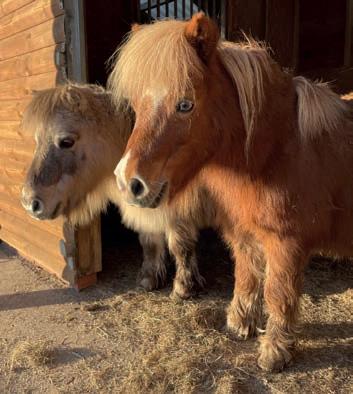 Competition winner
Welsh Section D Lynbrie Rhys, aka Oscar
Shetlands Joshua and Otis
Jon measuring Oscar's heart rate
Competition winner
Welsh Section D Lynbrie Rhys, aka Oscar
Shetlands Joshua and Otis
Jon measuring Oscar's heart rate
20 competition winner features | endurancegb.co.uk
Sue and Oscar are training for their Novice season



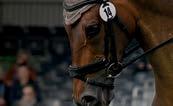



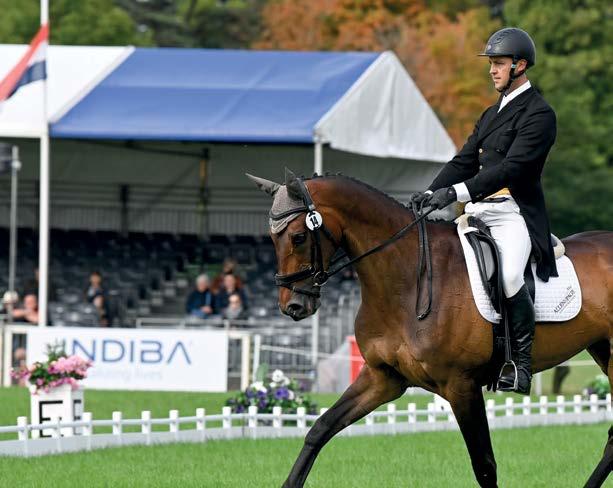





















Gain energy and support healthy gastric function A low starch, low sugar, high energy soaked feed High in fibre containing Beta-Glucans
Fully balanced with vitamins and minerals, no need to add a balancer* Contains a probiotic and a blend of prebiotics for healthy digestion No whole cereal grains, no molasses, no soya, no alfalfa Suitable for horses and ponies prone to gastric ulcers Contact our award-winning helpline for nutritional advice 01362 822 902 | helpline@allenandpage.co.uk www.allenandpage.com * When fed at recommended levels
Gubby
Leech and Royal Harvest
RoR news
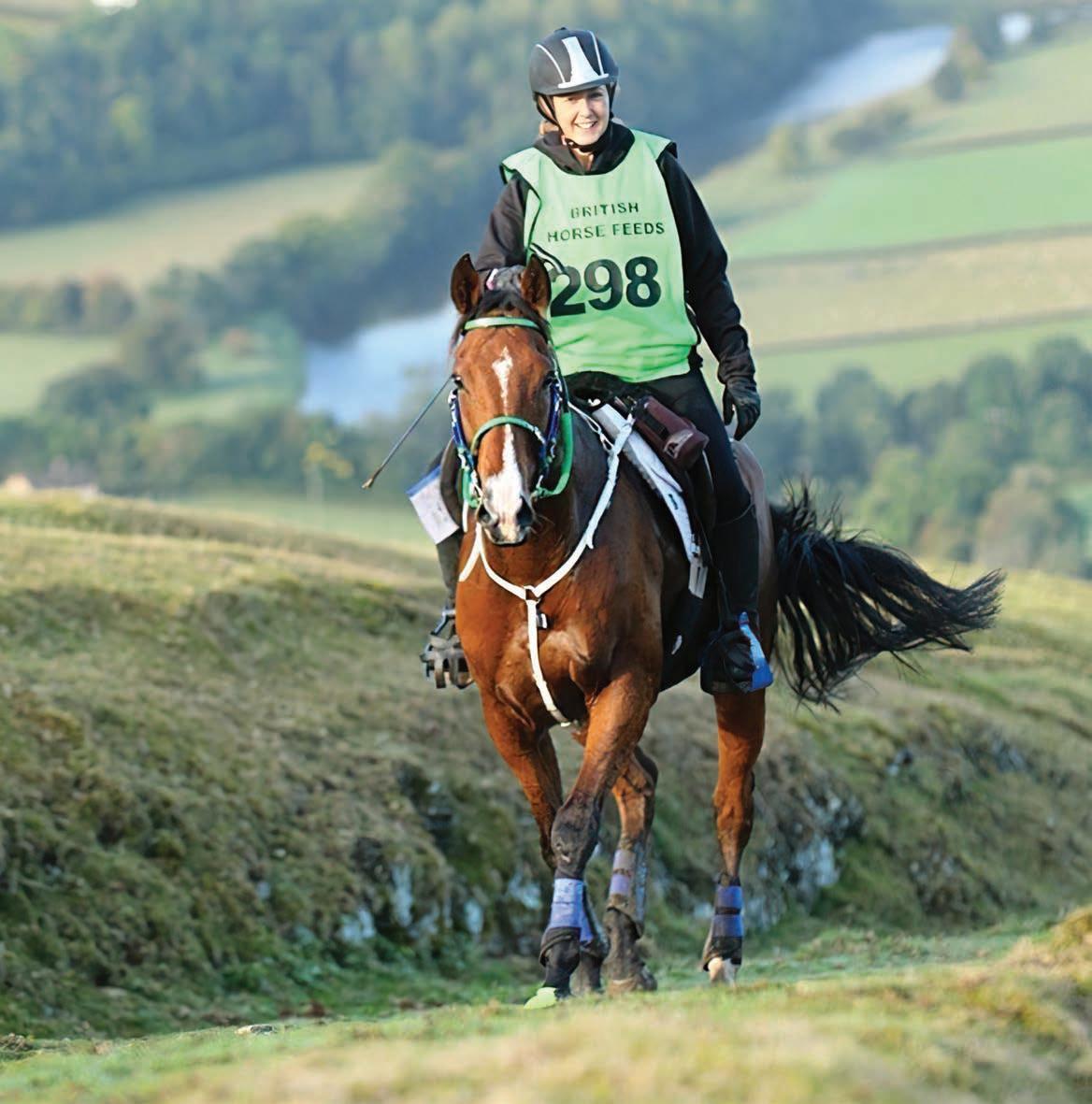
Anna Collins updates us on the latest happenings in the Retraining of Racehorses world
On Wednesday 31 January, Retraining of Racehorses (RoR) hosted its annual RoR awards ceremony at the historic Jockey Club Rooms in Newmarket. The glittering evening brought together more than 150 attendees from the racing and equestrian communities to honour the remarkable accomplishments of former racehorses in their new careers.
Richard Phillips, winning jumping and flat racehorse trainer, and Ashleigh Wicheard, works rider and jockey, skilfully hosted the awards ceremony, sharing inspiring stories
Worthy winners
of the winners, which created an emotional experience for the audience.
Congratulations to…
Amanda Hamley and More Salutes (Morse), who were the proud winners of this year’s prestigious Retraining of Racehorses Elite Endurance Award. The honour was bestowed on Amanda by former Endurance GB Chair, the wonderful John Hudson. Morse is an eight-yearold, Irish-bred former flat racer who competed 12 times on a combination of grass and allweather tracks including Kempton and Lingfield.
Amanda completed six rides (including two 65km rides), total distance 278km and achieved 543 trophy points – a clear winner with 161 points ahead of the next combination.
The award is run as a partnership between Endurance GB and RoR and is sponsored by the Jockey Club. As well as an award ceremony and trophy, the award includes a £500 prize.
Amanda said, “I’m so proud of Morse after all we have been through. The Jockey Club is a wonderful venue to have been invited to. We stayed over for part of the next day and along with some of the other winners, enjoyed the full experience with a visit to the gallops, the National Horse Racing Museum and Tattersalls.”
Tattersalls held a parade of their top 10 stallions including the magnificent Stradivarius. Now standing at stud, he was the legendary three-time Ascot Gold Cup winner with Frankie Dettori. Now wouldn’t he have made a brilliant endurance horse!
Amanda Hamley and Morse competing at Red Dragon
22 RoR news regulars | endurancegb.co.uk RoR news
Photo: David Saunders

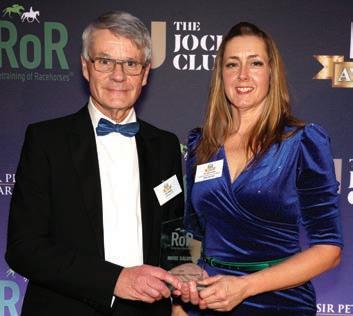
RoR 2024
Plans are in place to seek expressions of interest from RoR members who wish to compete in the Teams Championships which will be held at Well Vale in 2024.
Teams of 3-6 riders will have to ride together and qualify as a team at a nominated qualifying ride in a 32km class.
Anna Collins, volunteer co-ordinator of the Endurance GB and RoR partnership said, “We're planning to nominate a couple of qualifying rides in the north/midlands and the south, as well as Cirencester, so it's easier for teams to travel to qualify. Look out for information on your local RoR or Endurance GB Facebook pages. We'll email everyone registered with Endurance GB who is an RoR competition registered member.”
Endurance Seven
The E7 series, which was kindly sponsored by the Sir Peter O’Sullevan Trust, is still open. Riders claim prizes for distance completed. It’s not too late to start collecting distance on your record card which is available on the RoR Endurance Series web pages. Those who claimed distance rewards last season can keep their record cards going this year.
The usual Pleasure Ride completion rosettes, Novice Award and of course the prestigious Elite Endurance Award will be up for grabs again this year. Send any queries to endurance@ror.org.uk
Anna added, “Last season there were 48 registered Endurance GB RoR riders with 31 actively competing, which is a significant increase from the 20 or so we had four years ago. But, we also know that according to the RoR database, there are 154 horses holding current competition membership who have selected endurance as one of their disciplines. So if you know anyone out there with a former racehorse looking for something to do, please encourage them to join our wonderful sport of endurance. Thoroughbreds both love it and are brilliant at it. Let’s get them out there!
 Amanda Hamley More Salutes and Hayley Gilmore Art Mauresque at The Red Dragon start
A retrained racehorse can learn to stand still and be vetted as well as any other horse
Amanda Hamley More Salutes and Hayley Gilmore Art Mauresque at The Red Dragon start
A retrained racehorse can learn to stand still and be vetted as well as any other horse
23 RoR news
Amanda Hamley, winner of the RoR Elite Endurance Award
Product spotlight

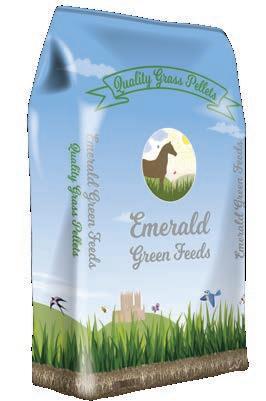

Heads up
The JS1 Pro jockey skull from Charles Owen is lightweight, deep-fitting and features an impact-resistant ABS outer shell with 10 ventilation slots. Upgraded leather look harness with reinforced nylon webbing and suede padding under the chin provides greater rider security and comfort.
From £110 charlesowen.com
Perfect pellets
Emerald Green Feeds’ Grass Pellets are made from a tall, leafy fescue grass grown in the UK. They contain good levels of protein and digestible fibre. The harvesting and drying processes ensure that naturally occurring vitamins and minerals and other nutrients are locked in and preserved. The pellets provide slow-release energy for condition and steady growth all year round.
RRP £13.15 for 20kg emeraldgreenfeeds.co.uk
Flexible friends
Flex-on stirrups use elastomer shock absorbers, which cushions the shock-waves from the horse’s movement, helping rider stability and reducing joint stress. The offset leather slot facilitates optimum leg position and contact with the horse, as well as an easily-regained stirrup if the rider loses it. They can be customised with a choice of designs and a special endurance footbed and tread is available.
RRP From £229.95
flex-on-fr
We take a look at some of our favourite horsey products on the market

Fibre providers
Baileys Horse Feeds’ Natural Meadow Cobs are made from late-cut perennial meadows that are high in fibre, yet low in starch, sugars and calories. They soak to a tasty fibrous mash for extended chew time alongside any existing balanced diet.
RRP £21 for 20kg baileyshorsefeeds.co.uk
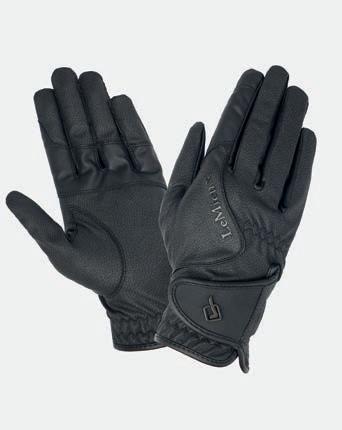
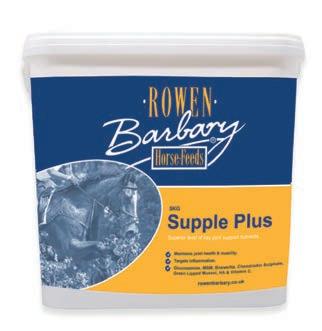
Close contact
Made from new, innovative technical fabric with a classic look, LeMieux’s Close Contact gloves are designed to be breathable to keep you cool and comfortable during active riding days. The double rein grip and new seam design allow sensitive communication on the reins. There’s a secure hook and loop closure alongside textured LeMieux branding for a signature finishing touch.
RRP £34.95 lemieuxproducts.com
What’s supp?
New from Rowen Barbary is Supple Plus, an advanced joint supplement containing key joint support nutrients designed to help maintain joint health, mobility and target inflammation. With Glucosamine, MSM, Boswellia, Chondroitin, GLM, HA and Vitamin C, Supple Plus is ideal for performance horses undertaking strenuous work. BETA NOPS compliant.
RRP £34 for 1kg rowanbarbary.co.uk
24 horsey shopping Horsey shopping regulars | endurancegb.co.uk

Brings delicious grasses into the bucket For all horses & ponies - ideal for veterans Close-to-nature



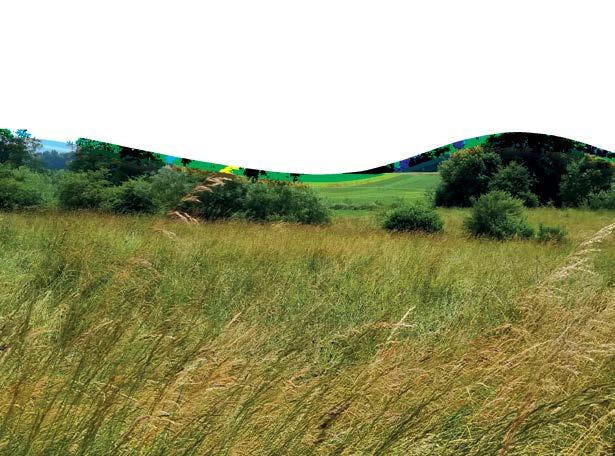
SMELL THE GRASS!
For information & a sample Tel: 01371 850 247 (option 3) info@baileyshorsefeeds.co.uk www.baileyshorsefeeds.co.uk
Tasty forage alternative Low calorie Adds fibre variety TO SOAK
chew time from Pre-Alpine meadow grasses & herbs

British Breeding Futurity evaluations
Karen Corr reveals what’s involved in the Young Horse Futurity Scheme
The British Equestrian Federation Young Horse Futurity Scheme first admitted potential endurance horses for evaluation in 2009, alongside those from the Olympic disciplines of dressage, eventing and showjumping. I happened to be one of the first Endurance GB members who took this opportunity to have a home-bred Arab filly and her half-sister evaluated back in 2009/2010 and last year I took another twoyear-old to be evaluated.
Why?
The Futurity is principally run to identify talented young sport horses and ponies, for collecting data on British breeding so that British breeders can make use of that information for future breeding decisions and for providing feedback to participants on the suitability of the horse they’ve bred for its intended discipline and the market for which it has been bred. This is important to remember because not every horse will be an elite one. The biggest sector of the market is the amateur affiliated sector, and this market typically requires horses with slightly different attributes to elite horses.
Futurity is for amateur and professional owners/breeders alike. High scores have come in equal measure from established studs and one-horse owners so don’t think that the Futurity isn’t for you because you are a small breeder or one-horse owner. If you have a passion for sport horse or pony breeding and have bred from your own mare or have bought a future endurance horse or pony, then the Futurity is for you!
As an endurance rider, I believe the Futurity evaluation gives you a thorough assessment of your horse’s potential for future performance in horse sports like endurance. It can highlight faults which can be managed over your horse’s lifetime or even corrected by good farriery.
What is it?
The Futurity is an evaluation, rather than a sport horse show class. At a show your horse will be ranked in order of preference by a judge, whereas at an evaluation your horse will be marked using a set of criteria appropriate for that horse’s age and intended discipline. At an evaluation your horse is considered for longer than at a show and the feedback you receive will be much more thorough.
Evaluations are generally held around the country in July/August each year and offer breeders and owners the chance of an unbiased assessment of their horses, as well as
the opportunity to identify those bloodlines which consistently achieve high scores, and which go on to compete within their chosen disciplines at the highest levels. As a result of Covid, evaluations in 2020 were undertaken virtually online, using the same processes and criteria. From 2021 evaluations were once again undertaken at some physical venues as well as continuing by virtual assessment. Full details of the Futurity Scheme are available at: britishbreeding.com/futurity
Preparing for evaluation
Most evaluations are carried out at large equestrian centres with both outdoor and indoor arenas. The centres I’ve been to in the
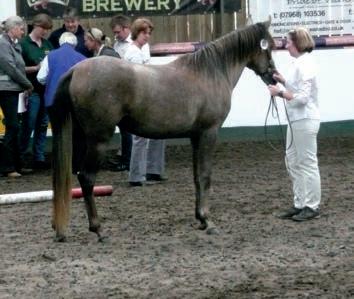
futurity features | endurancegb.co.uk
Photo: Nick Gill
Futurity 26
Riyah Raquassah in front of assessors
past have used their indoor arenas for the assessor’s evaluation and outdoor areas for the vet’s evaluation. There’s a host of information on what to expect on the British Breeding website but here are my top tips for getting your young horse prepared…
1. General handling. Get them used to strangers walking around them from all angles, picking up feet etc. It’s always easier to assess a horse who stands still and square, walks and trots obediently in a straight line and on a circle/triangle – the assessors will appreciate this!
2. Go to some local shows. This gets them used to travelling, meeting strange horses, standing in front of a judge and you can practise your walk/trot in-hand work in a strange environment.
3. Hire an indoor arena as they have different acoustics which can be unsettling for a youngster. Practise your stand, walk and trot in a straight line, walk and trot on a triangle and also letting them loose to show off all three paces. Canter can be a challenge as lots of horses love to show off their groundcovering trot and get faster and faster! If you can voice train a canter then this will be a big help! Can you catch them after you’ve been chasing them round and their adrenaline is up? Treats are allowed!
4. Foot balance. I think a lot of people don’t take this seriously enough but it’s a very important part of the vet assessment. Don’t leave it until just before the event, get advice from your farrier or vet months before so that any adjustments can be made over time.
5. Bridles. Personal preference, but I’ve used a traditional in-hand leather halter for youngsters up to two years old. Three-yearolds must wear a snaffle bit, so they’ll need to get used to wearing that beforehand.
6. Handler’s outfit. This is open to interpretation but should be smart and tidy. I wore cream trousers and a white shirt for my first appearance and this time wore dark coloured smart jeans, a white shirt and dark gilet – and don’t forget gloves and a hard hat!
7. On the day. I’ve always treated the Futurity like I’m going to a show so always bath my horses beforehand and have them gleaming. Having only ever taken pure-bred Arabians for assessment, I’ve never felt the need to plait their mane, but this year I decided to have a go and it looked smart! It’s useful to have a helper with you on the day, especially for the loose assessment ,since some arenas are very large and you’ll need a couple of people in there to keep the horse moving and stop them hovering around the exit!
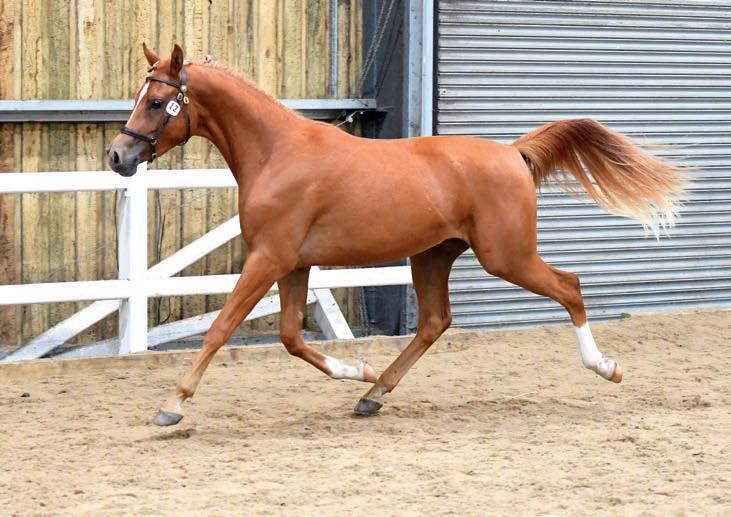
My Futurity horses
In 2009 and 2010 we took our home-bred Arab filly and her half-sister to the evaluations. Both were sired by the Pearl Island Stud’s, Krayaan Dilmun, who’s had several offspring assessed with good results. The gradings have changed slightly over the years but back then both Riyah Raquassah (Lottie) and Hamra bint Krayaan (Hamra) gained Higher First Premiums. Lottie was the first ever endurance youngster to win the Phoenix Field Arabians Endurance Futurity Trophy which is kindly sponsored by Peter and Jo Claridge and is awarded at the Endurance GB AGM each year to the member whose horse (foal to three-year-old) receives the highest score in the British Breeding Endurance Discipline Futurity Evaluations during the year. She went on to progress through the ranks to become an Advanced level endurance horse and is still with us aged 17, but now retired from competition. Hamra progressed to Open level and was just one ride off becoming Advanced before being sold to a non-endurance home.
I’d searched for a young Arabian to become my next endurance horse for about 18 months, when a friend told me she knew of a foal who might be for sale. She was convinced he’d tick all my boxes. When I saw Geno aged seven months old, standing proud with his dam on that Welsh hill, I knew that he was the one. The icing on the cake was his pedigree which contained two of my desired performance lines – the Biddesden Stud, Dhruv line through grade 1 racehorse Abishai, and the infamous endurance line of Ben Rabba.
All credit into Geno ibn Mansoura’s breeding goes to Dean Richards (owner of his sire Geronimo) and Eve Barber (who chose her daughter’s mare Mansoura bint Abishai, aka Soura). Their aim was to create a horse for performance, speed and temperament.
Geronimo has an interesting pedigree which contains some of the most important and now very rare Polish Arabian performance lines through his dam Ozana. Geronimo’s sire is
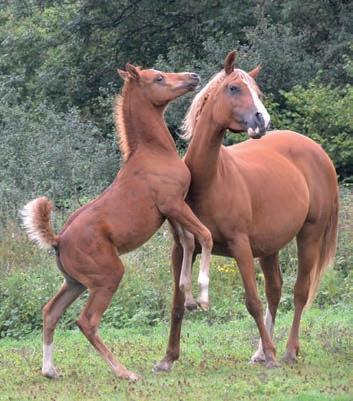
the prolific Arabian stallion Master Design GA who has four lines to Bask. Although never competed himself, Geronimo has superb legs and feet with an athletic frame. Soura was an immense mare of incredible substance who carried over 75% Crabbet/OE bloodlines. The pairing was designed to refine this without compromising quality and agility – Geno’s futurity grading of Gold has certainly confirmed that this was a great decision!
I’m so grateful to Eve and Dean for deciding he could spend the rest of his days with me. He’s a sensitive, sweet-natured boy. Not only is he easy on the eye, but he also has amazing ground covering smooth, efficient paces, loves being with people and is the type of horse you enjoy spending time with – an absolute ‘musthave’ quality in an endurance horse!
Geno’s futurity result in 2023 meant he also won the Phoenix Field Arabians’ Futurity Trophy with Endurance GB. My development of this Futurity graduate is likely to be significantly different to Lottie and Hamra as we’re always learning and tweaking our management and training. It’s now time to nurture what nature has provided for me.
futurity
27
Geno at the Futurity evaluations
Photo: Nick Gill
Geno and his dam
Pull it all together
Train for the Terrain
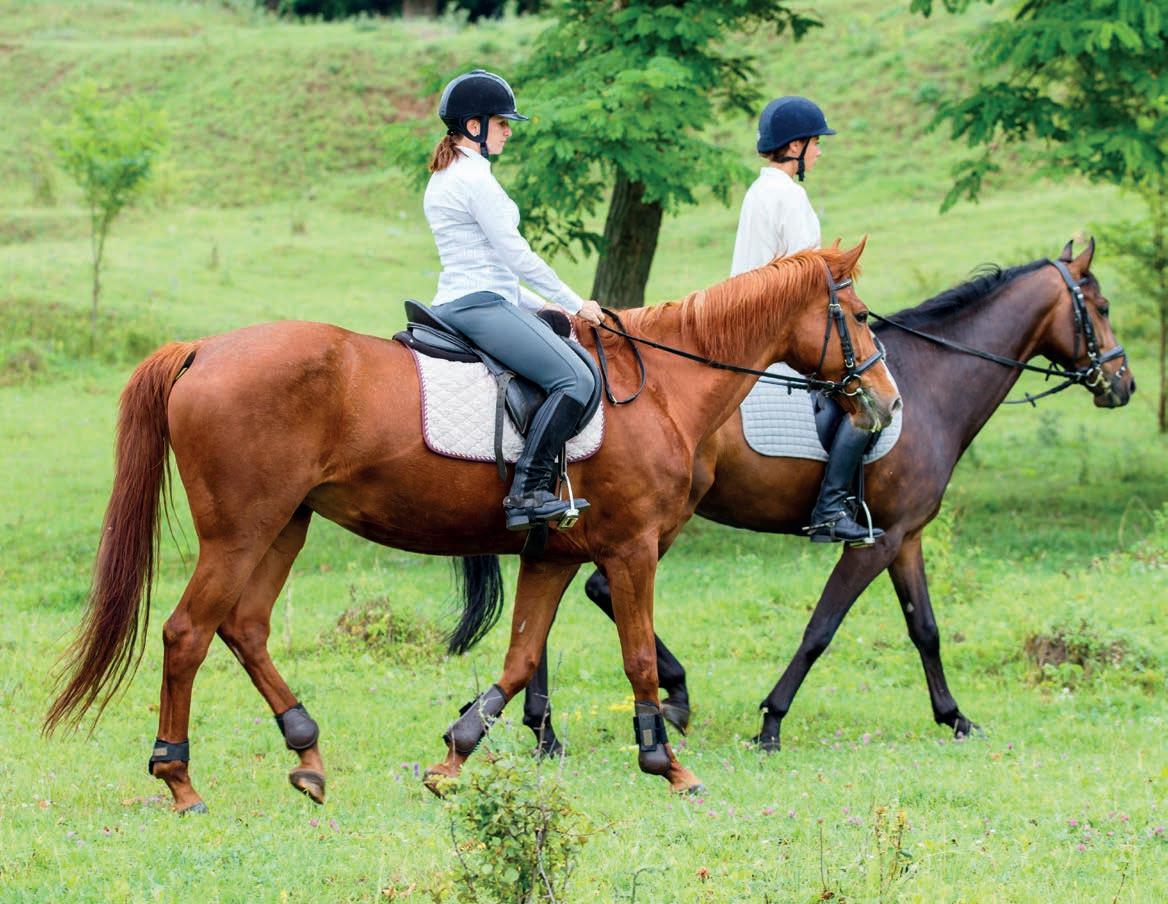
as well as finding places to enjoy being out and about (and training) with the family, bringing on the next generation.
About Maggie
Maggie is OntheHoofDT. She’s worked with endurance horses and riders for over 25 years from grassroots to world contenders and is a fitness specialist. She’s been an integral part of the Mongol Derby team since 2009 –head of rider training. Maggie delivers training lectures for BHS coaches and colleges focusing on endurance fitness and works closely with vet practices on rehabilitation programmes and foaling preparation and delivery.
I’m delighted to finish the series ‘Train for the Terrain’ with a round-up and professional’s view of what that means.
There’s a theme that runs through the series which delights me. Each contributor has mentioned their own beautiful terrain and countryside, alongside comments of being able to enjoy it with their best friend – the horse –
So many positive comments flew from the pages, such as, “despite the challenge of the roads, access, weather etc, we managed to make use of the hills or find a way through”. Well done. We need to send your stories out to the wider equestrian public to show them how endurance riders train for the job and what a fabulous sport it is.
There’s been great advice from well-seasoned riders and some sayings that have possibly been lost along the way. These are a few I picked out.
“As fit as you need to be to do the job”, “Using the unevenness and rocky ground as an alternative to polework”, “Trot all of the time, canter when you can and walk if you must”, “Exercising on the beach is more than just a bucket list wish”, ”Benefits of walk work and hills is underestimated”, “Hills enable you to increase the intensity of work without increasing the speed”, “Variety of surfaces”, ”Only so many miles in those legs”.
Many riders happen upon the sport because they don’t want to jump or do dressage or have finished with big cross-country fences. However, it’s a big mistake to think your endurance horse doesn’t need to be schooled.
An endurance horse needs to be balanced, have self-carriage, be able to tackle a variety of terrain, go over and through water, bridges, tunnels, roads, often finding challenges in competition they’ve never seen before. It’s about building a bond and trust which goes both ways. If the ground is dodgy I want to be able to drop the reins and say, “down to you my lovely” and equally if something scary is ahead I want my horse to trust me enough to know I’ll answer the question of, “is this okay?” with “it’s fine, I’ve got this”. And, in the situation where we’re both bricking it, knowing we’ll give it our best shot – we won’t get it right every time but that’s life.
School’s out
So, if schooling is a must, do we need a school? No, not necessarily, but I do believe a session a week in a controlled environment is useful for both horse and rider and if nothing else, use this session as a time to practise your warm-up. We should never cross the start line without a warm-up – not necessarily just about warming up the working parts for you both but more about the connection between the two of you. Get a little routine together and even when you’re riding with a friend, take yourself and your horse off to do the routine before
Maggie Pattinson rounds off our Train for the Terrain series with a professional’s view of what that means
28 training features | endurancegb.co.uk
Photo: Sergii Kumer/Shutterstock.com
heading for the start. You have half a chance of understanding each other’s agendas that way. If you’re looking at a faster start you need a proper warm-up.
That formal session could also be vetting practice – trot ups, heart rates, standing still. Where better to practise routine than in a home environment?
So if one schooling session is formal, the rest should be where endurance riders are more comfortable – out and about – and this is where we utilise what we have around us – ‘schooling off piste’.
Walking should always play a huge part in your plans no matter the terrain – walk a horse fit, gallop it dead – just saying! Work the walk and use it to check yourself out, too – long rein/ contact, halts, half-halts, lengthen and shorten the stride, add some lateral work. If your doorstep is roadwork make it count.
If you have hills, divide them into, say, thirds and add a halt, counting to five on each of those thirds. Road works, traffic, scary stuff in general, put your schooling moves into place – leg-yield away and then towards a problem.
Never hesitate to dismount but make sure finding places to get on and off is part of everyday training. Can you balance on a pole, stand on a bench or log or will your horse stand in a ditch for you? Can you get on from the ‘other’ side?
Controversy always surrounds the subject of trotting on the roads but some is going to be necessary. It’s not about hammering along, but light and balanced will only help prepare those legs. Be prescriptive about the strides you cover, using changes of rising diagonal to strengthen and straighten. If roads are what you have, make them count!
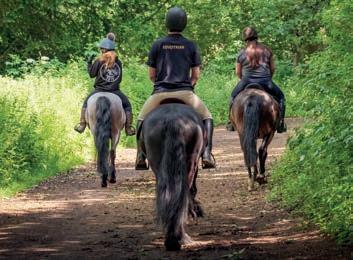
Use your imagination
Forestry and woodland are great places to play with balance. Use the rooty ground to gain trust and use your body rather than reins (another saying 'use your reins to conduct the music not steer the car') to keep a rhythm while allowing your horse to pick his, not your, way through. Add weaving in and out of trees and you’ll be riding a complex competition track with ease.
Add left and right turns to your voice and not only will your horse see the markers, he’ll be watching them. If you don’t have gates to practise but know your ride will have many, use halts and turns on the forehand and quarters to practise the movements of opening and closing gates. Use trees, bushes or whatever is around you, but most of all use your imagination.
Hills on good going can be great but also dangerous, so don’t just bomb it, do some walktrot-halts. Divide the hill into thirds. Trot, halt, walk, halt, trot and include some canter to build muscle, stamina and cardiovascular fitness. Use leg-yields and other lateral moves instead of braking, weave down a hill, pushing the quarters over as you turn to get some step under.


Canter banter
Canter work is often the most difficult to achieve efficiently and sufficiently, especially for those looking at longer distances on flatter, faster rides, but if a lot of canter is to be done it must be achieved somewhere in training. Although canter’s probably the most efficient and almost a rest pace, it uses a different set of muscles and balance.
Beaches are great but also carry risks, so checking out where you are is a must. Walk and trot along it before cantering
Moorland, long woodland tracks and bridleways can be fabulous but often littered with other users and hazards, but if that’s what you have use them well.
Have a routine to warm-up, using lots of trot. Incorporate changes of diagonals and lateral moves before attempting canter. So, when approaching a canter area, get that trot (pump up) done, start with 30/40 strides of canter and return to some trot routines then gradually increase the canter strides, aiming for an uphill canter continuously. If you’re getting pulled, don’t pull back. Instead, weave from side to side as this takes the horse’s eye off the horizon and creates the need to focus on where his legs are.
Fun times
Remember to have fun – a great thing to get in each week, no matter what, is time in the saddle. Emulate the time in the saddle needed for your chosen competitive ride, not the distance. Have a meet up somewhere – pub or picnic ride – and practise your in and out of vet gates. Check how everything is feeling from the tack to the ears. Try something new, have a blast, make this your time to enjoy where you are and who you are with.
Fit for the job is a pet saying of mine. I believe too fit is as bad as not fit enough. A holistic approach should be looking at fittening every aspect of the horse – legs, bones, tendons, ligaments, muscles, heart, lungs and mind. Often I see young, talented horses whose physical capability is ready far faster than mentally. Equally, I see young and older horses bored and making their own entertainment because 32/40km is too easy.
training 29
Use wooded areas to work on balance
Use schooling to practise your warm-up
Canter's probably the most efficient pace
Photo: Nick Beer/Shutterstock.com
Photo: AnnaElizabeth photography/Shutterstock.com


Tying-up
Knowing how to reduce the risk of your horse tying-up, the potential causes and what to do if it happens is essential
Tying-up is a catch-all term that’s used for a wide range of muscle conditions. In endurance these can be anything from muscle cramping in a vet gate to the classic incident of a horse stopping and being unable to move forward during the first loop of a ride. In all these cases, the horse is suffering from the clinical signs of rhabdomyolysis (muscle breakdown).
There are multiple causes of tying-up and it’s important that horses are worked and managed in a way to prevent recurrent episodes which will impact welfare and limit performance.
A bit of science
Muscles are complex tissues which rely on proteins, sugars and electrolytes to be in perfect balance to function correctly. Muscle contraction and relaxation both require energy to move calcium into and out of intracellular storage sites.
Muscles use glucose as energy and store this glucose as glycogen. In horses who have tied up, there’s a disruption in the perfect balance
of proteins, sugars and electrolytes. This leads to muscles continuously contracting, which is very painful. Muscle damage and breakdown then occurs, leading to the release of myoglobin, which is toxic to the kidneys in high levels.
Clinical signs
It’s essential to familiarise yourself with the clinical signs of tying-up. These include, but are not limited to…
• a stiff gait or reluctance to move
• rigid muscles that are painful to the touch (often the lumbar and gluteal mucles)
• muscle fasciculations
• tachycardia (increased heart rate)
• tachypnoea (increased respiratory rate)
• excessive sweating
• pigmenturia (chocolate coloured urine)
• horses can become recumbent (in extreme cases)
If your horse exhibits signs of tying-up, you must stop exercising him and contact your veterinary surgeon. If you’re in the middle of a ride, contact one of the marshals for immediate assistance. Where possible, horses should be boxed back to a stable to be assessed.
Causes of tying-up
As I said earlier, there are a multitude of causes of tying-up. Sporadic cases can occur because a horse is not fit enough for the type of activity they are doing, or they’ve pushed themselves too hard. Recurrent bouts of tying-up often occur in endurance horses due to asymmetrical movement. This can be due to the rider not sitting straight, poor saddle fit or subtle lameness, often in the hindlimbs.
In other recurrent cases, there can be an underlying disease of the muscles themselves, preventing them from functioning properly. There are many different myopathies which can be inherited, and the most commonly encountered disease is polysaccharide storage myopathy (PSSM). Type 1 PSSM is due to a mutation in the glycogen synthase enzyme involved in the production of glycogen in the muscle cells. This leads to the excessive production of glycogen and issues with breaking this glycogen back down into glucose to be used for muscle contraction and relaxation.
In some cases, horses will show signs of tying-up without having done any exercise. This can be due to sycamore poisoning (atypical myopathy), nutrient deficiencies, toxins or diseases (such as tetanus).
vet's viewpoint features | endurancegb.co.uk Vet's viewpoint
OUR EXPERT Caitlin Milne MA VetMB MRCVS is a vet at Damory Equine Vets in Dorset.
30
Photos: Charly Morlock, Anna Elizabeth Photography, Sharon Kingston, Jaromi Chalabala, Samoli/Shutterstock.com

Your vet's likely to take a blood sample
Diagnosis
If you suspect your horse may have tied up, it’s important to get him seen by a vet. They will perform a full clinical exam and will likely take a blood sample to check the muscle enzyme (AST and CK) levels. Muscle enzymes are found in increased levels in the blood following muscle damage and can be an important indicator of how severe the muscle damage is.
Your vet may also check the urea and creatinine levels in the blood which are an indicator of kidney function. High urea and creatinine levels (known as azoturia) can be fatal.
Horses recovering from repeat episodes of tying-up can be tested for genetic diseases. A hair sample can be sent off to diagnose PSSM1 and muscle biopsies (often of the hamstrings) can be done to diagnose other diseases.

Ensure your horse stays well hydrated
Treatment
Treatment will vary depending on the circumstances leading to the tying-up episode. If the horse has been competing, normally the competition vets will administer fluid therapy orally and/or intravenously. This will aim to re-hydrate the horse as well as replenish electrolytes. Anti-inflammatories and muscle relaxants may also be used.
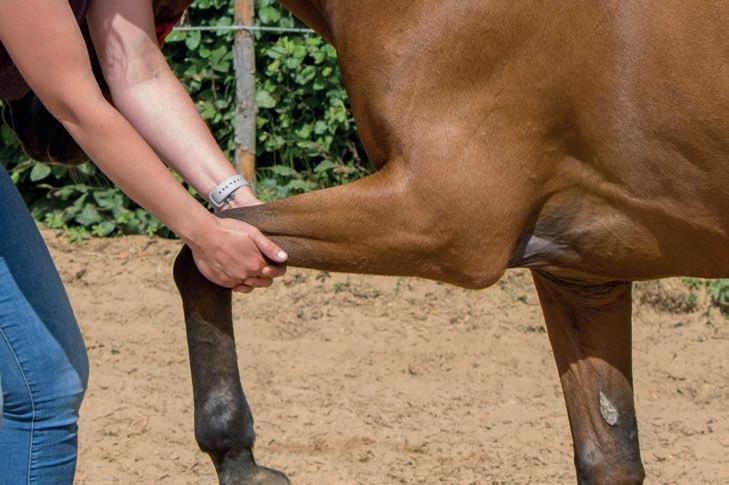
Prevention is better than cure!
It is important to make sure that horses are suitably fit for the activity they are doing. Horses who have had time off must be brought back into work slowly with periodic increases in workload to help improve fitness. During this period, you should make sure you have a good physiotherapy and veterinary team checking your horse for any signs of lameness. Your saddle must also be checked at least twice a year, and especially when your horse is changing shape as he comes back into work. A good human physiotherapist is also very important for the rider to ensure they are riding symmetrically.
Horses who are prone to tying-up really benefit from a regimented daily routine with little stress and excitement. Daily exercise is recommended such as a period on the horse walker, or on the lunge. These horses rarely benefit from time off when not in an active tying-up period. It’s important to warm-up and cool down these horses for extended periods of time as well.
Diet plays a huge part in preventing typingup episodes. Horses who tie up benefit from a diet low in carbohydrates such as starch and glucose. Ideally less than 10% of the diet energy should come from starch, with the lost calorific content replaced with oil-based feeds.
When competing, endurance horses should run on a fibre-based diet utilising high-quality forage and chaff feeds such as alfalfa. A balancer can also be used. Additional energy can be provided by adding in vegetable oils. Start with 50ml daily to increase to a maximum of 1ml/ kg of bodyweight per day over a period of 2-3 months, split between the feeds.
Electrolytes should also be added into the feeds of horses that tie up – 15g of both table salt and lyte salt twice daily in food has
Have
been shown to help these horses. This can be increased depending on workload.
Electrolyte and hydration status must also be considered when travelling horses to and from competitions. Make sure you stop regularly to provide your horse with water and offer him electrolytes, either in a second bucket of water or in a small feed.
Special attention must be paid to mares who are more prone to tying-up just after ovulation and do not absorb electrolytes as well. Once you’ve arrived at the competition, make sure your horse has access to fresh water immediately and increase their electrolyte consumption. If you have any concerns, notify the on-site veterinary team.
Certain supplements are also recommended in cases of recurrent tying-up. Vitamin E can be given at a total of 4,000IU per day. It’s important horses are not supplemented with long-term selenium, which can be found in some products in combination with vitamin E, as this can lead to toxicities.
Finally, during rides, make sure horses stay warm in the vet gates and are warmed up and cooled down appropriately for exercise.

vet's viewpoint 31
Feed endurance horses a fibre-based diet
a good physiotherapist in your team

Polka Dot Challenge
Find out more about the Polka Dot ‘Champion of the Mountains’ Challenge
The Polka Dot Challenge is designed to encourage participation at the hilly rides on the Endurance GB schedule and will replace and expand on last year’s Western Hills Challenge.
The idea of the Polka Dot Challenge is to emulate the Tour De France which gives a special ‘Polka Dot’ jersey award to the cyclist who does best on the mountain stages. For this new award, placings will be calculated only on cumulative mileage with the same rider on the same horse so as not to advantage high speeds or low heart rates
Prizes will be as follows…
• Open Graded rides – 1st £200, 2nd £100, 3rd £75
• Novice Graded rides – 1st £200, 2nd £100, 3rd £75
• Pleasure Rides – 1st £100, 2nd £50, 3rd £25.
A list of qualifying rides for the Polka Dot Challenge will be published very shortly on the website and via social media.
Riders are invited to register for the competition at the end of their season by completing a form stating their mileage and their category. Results will be calculated using verified ride entry lists on the website and placings will be announced at the end of the season.
The Tour de France gives a ‘White Jersey’ award for the highest placed young cyclist. Instead of a jersey, there will be a special white rosette for the highest placed Junior and Young Rider in each category.
Among the qualifying rides will be a selected few that offer double points for the Polka Dot

Challenge and these rides will be identified at the same time as the qualifying list.
Terms and conditions of the ride will also be published shortly.
Results from the Western Hills Challenge 2023 are…
• Open/Advanced Challenge – no awards
• Novice Challenge – 1st Briony Dobbs on Hazetree Tenor
• Pleasure Ride Challenge – 1st Holly Wright and Danrhyd Golden Glory, 2nd Jill Thorburn and Kamar Ibn Muhaned.

Polka Dot Challenge
Stanage Pole
Photo: IndiePics
Holly Wright
Briony Dobbs
Photo: IndiePics
32 polka dot challenge features | endurancegb.co.uk
Photo: David Saunders Photography
From the office

We meet Endurance GB’s new Office Administrator, Kara Barnes, and wish her a warm welcome
Hello, my name is Kara Barnes, and I am the new Office Administrator for Endurance GB. I have been around horses from a young age, and I especially enjoy the freedom of being able to ride in the open countryside, admiring the views and spending time with my best friend. I own an Irish Cob called Oliver Twist (Ollie). He’s been my rock for nearly a decade now and we enjoy exploring the countryside and nearby villages.
I’ve spent the past three years completing my degree in equine performance and therapies, recently graduating from the
University of Northampton. Studying the performance of horses from a variety of disciplines, I spent a large amount of time analysing the fitness of horses and the different benefits these therapies achieve, to improve the performance of these amazing animals.
Prior to going to university, I studied my GCSEs and A-Levels at Southam College, having the pleasure to compete with Ollie during my time at school.
Alongside the equine world, I volunteer as club secretary for my local cricket club, Barby. I also enjoy watching football, being a big Arsenal fan, walking my two Labradors Milly and Kizzy, and spending time with my family and friends. My happy place is a town in Norfolk called Hunstanton, and my dream is to get Ollie there one day for a lovely gallop along the beach.
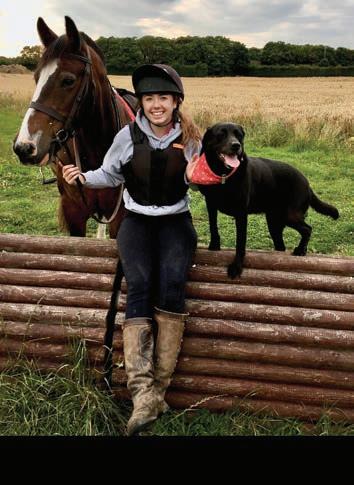

From a young age I always dreamt of having a job in the equine industry, and I look forward to supporting the members and hopefully joining them one day with Ollie.
Endurance GB’s Chairman, Phil Nunnerley, adds, “Kara joins us on 11 March. She was the outstanding candidate in both her application and interview. In her references, highlighted are her organisation and communication skills; and her obsession with focus on the customer. Our members will be spoilt!
“With a degree in equine performance and therapies, a background of working with horses and having a horse of her own, Kara is an ideal fit to support us all. We just have to encourage her to come and try endurance!
“Please extend to her a warm welcome, and be understanding while she builds her knowledge of all our processes.”
Kara and Ollie love riding in the open countryside admiring the views
Office update 33 regulars
Kara enjoys spending time with her horse Ollie and Labradors Milly and Kizzy

We find out more about the team behind The Golden Paste Company and British Horse Feeds
I'Anson Brothers
The Golden Paste Company (GPCo) and British Horse Feeds (BHF) are divisions of I’Anson Brothers Holdings, one of the UK’s leading manufacturers of premier animal feedstuffs. They’ve been serving farmers in Yorkshire and Northern England since 1900 from the small market town of Masham, at the foot of Wensleydale in the Yorkshire Dales. BHF is the equine feed division of the family business with their flagship products revolutionising the feeding of soaked mash. In 2017, the company expanded their portfolio of products and purchased GPCo, specialising in turmeric-based supplements for equines, pets and people.
Established in 1900 by Great Grandfather Christopher I’Anson, the business is still totally committed to its family-run roots. Now it’s the fifth generation of the family – Hattie, Charlie and Kate – who are ensuring the company values remain constant.
Hattie I’Anson (International Export Sales Manager) has been involved with the business for as long as she can remember, commenting, “From sticking on labels in the warehouse to helping at shows, I've done it all!”. Hattie is joined in the team by Branca Gebbie, Business and Trade Manager who has owned and been around horses and dogs from a young age. Branca adds, “My time now away from work is normally spent chauffeuring my daughter and
her pony to different venues to compete in Pony Club activities, while trying to find time to fit in and ride my own horse as well.”
The whole team is deeply rooted in the equestrian industry, with most of them having their own horses. Sarah Chantrell, who has joined the team as Business Development Account Manager, and Kirsty Holmes who is the Area Sales Rep for the South East are both keen horsewomen, while Martin Bielby whose role is National Accounts Sales, is an ex-National Hunt jockey and trainer. Meanwhile Kirsten Baul, Office and Logistics Manager and Hannah Elsworth, Customer and Sales Coordinator, have a menagerie of cats, dogs, horses and cattle between them. The team is also closely supported by Nutrition Consultant Dr Tom Shurlock, who works with GPCo and BHF on formulating the products.
Journey into endurance
BHF have been dedicated sponsors of the Red Dragon Festival of Endurance for nearly 20 years and jointly with sister company, GPCo for the past three years. Involvement in the event includes being on hand during the weekend for feeding advice, presenting prizes, and getting involved in crewing for competitors. The business is passionate about endurance because it’s a fascinating sport with horses and riders covering many miles across tough terrain.
Unlike many more specialised equestrian activities, endurance is open to all kinds of horses and riders, with classes for every distance and ability catered for.
The lowdown on turmeric
Turmeric has been used for human health for thousands of years and more recently its benefits for horses and dogs have also been recognised. GPCo has done plenty of research and testing on different types available.
Due to turmeric becoming so popular in the western world recently, there’s a higher risk of turmeric supply being cut, to make it go further. Therefore, we have to be careful on where and how we source our raw materials.
GPCo ethically sources turmeric from local farmers in Java, Indonesia, which is the highest strength turmeric you'll find in the world.
Turmeric has many benefits for horses including aiding joint health, supporting the body’s natural inflammation cycles and boosting integrity of the natural defence mechanisms, maintaining general health. Digestion can also be aided by turmeric, as it supports the microflora which naturally occur in the stomach, and helps to keep the horse's coat and skin healthy.
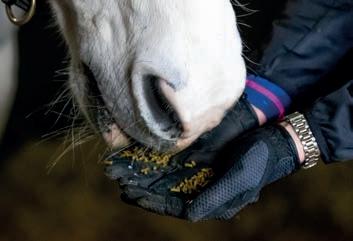
sponsor focus regulars | endurancegb.co.uk
Sponsor focus
34
Turmeric has many benefits for horses

Mash products can help with rehydration
Mighty mash
For the production of soaked mash products, it’s critically important to BHF to only use the highest quality beet pulp – with increasing globalisation, it’s possible to source the material anywhere in the world. Despite this, BHF only sources from the British Sugar Factory at Wissington who only work with local contracted farmers. This ensures and maintains quality of product that our customers expect.
These BHF soaked mash products are often used for endurance horses for rehydration and a source of slow-release energy. They are suitable for a variety of equines as part of a balanced diet due to their low levels of starch and sugar and are a versatile feed with a prebiotic effect due to the beet fibre. The products go through a unique cooking process for improved nutrient availability and are a highly palatable and digestible feed.
Planet Earth
The planet is important to us and therefore, manufacturing top-quality, natural turmericbased products with an emphasis on sustainability is essential. As well as getting ethically sourced turmeric from farmers in Java, Indonesia, we use organically grown raw ingredients purchased from like-minded people and businesses. All the GPCo packaging is also fully recyclable. We continue to invest in three core elements – people, product and planet. We're constantly looking at ways to improve sustainability goals and take our responsibility for the environment very seriously.
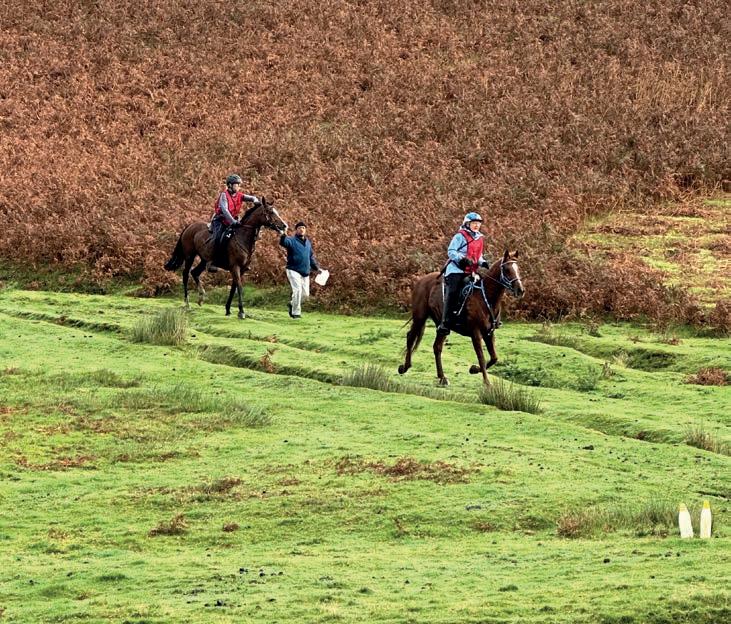
Crewing at an endurance ride can be great fun
A tale to tell
Customer and Sales Coordinator Hannah Elsworth has had some great experiences crewing, remarking, “One thing that sticks in my mind is in 2022 when I attended Red Dragon and gained my first experience of crewing. I’m used to handling horses as I've been a horse owner myself for over 20 years. However, I wasn’t used to handling strong, keen Arabs! I was asked to hold the horse I was crewing for at a vet gate. The horse had just been tacked up and was ready to go. I got pulled over and dragged across the field before managing to get

back on my feet. I’m confident to say I’m not the only one this has happened to!”
Hannah also adds about her experience with endurance, “The crewing experience is just amazing, even though it can be slightly stressful at times. Particularly when you are trying to navigate to certain check points on time as it’s an extremely crucial part of endurance riding. You’re basically helping to provide care for both the horse and rider, ensuring they have a successful ride.”
For more details, visit: britishhorsefeeds.com, goldenpastecompany.co.uk

regulars
BHF purchased GPCo in 2017
35
Looking after horse and rider on course

News Scottish Endurance Riding Club
For the last four years, the SERC PR group has run the early season training programme, Fit2Start. I’ve taken part in it each year and it’s helped me prepare for the season. It's an eight-week programme that starts in February and has four classes.
Class 1 is in-hand polework only and TREC style challenges.
Class 2 is combined polework (first four weeks) and ridden (weeks 5-8).
Class 3 is ridden and aimed at those who haven’t been able to train consistently over the winter.
Class 4 is ridden and aimed at those who have managed to train over the winter months.
It’s optional to do the polework and TREC challenges for classes 2-4, but I feel they are good
for horses and fun to do. The programme is free if you’re a SERC member, but non-members can also join in for a nominal fee.
When I looked at the programme for 2023, even though I had broken my wrist in October and my horses hadn’t been ridden as much as they'd usually be ridden, I decided I’d enter class 4, as I knew if I found it too much, I could downgrade to class 3 at any time.
Here’s the training plan…
36
scottish endurance
Endurance
Penny Hudson talks us through her 2024 season fitness plan with her horse Flossy
Scottish
regulars | endurancegb.co.uk
All photos courtesy of Kris Clay, topgearphotos.com
Week one
Week one – 10km. This went well and I completed 10km at 7.2kph. I have great hacking from home, so with a combination of roads, tracks and fields, my first ride was successful.
I decided to have a go at the polework – a good opportunity to have fun on the ground with Flossy. The polework was devised by Robyn Dunn, who is the physio to the British Endurance International Squad. We set up three poles for Hogs Back, Sway back and Slalom. I started with the poles on the ground, as Flossy and I hadn’t done much groundwork recently. She did really well and after a few repetitions, I raised the ends, and Flossy walked smoothly and calmly over them.
The TREC challenge for week one was to do a 30m trot up. This was a nice straightforward task, as we do this at SERC rides – still good to practise it though.
Week two
Week two - 15km. I split this into two rides with the plan of doing a flatter ride a bit quicker and then a hilly ride at a more leisurely pace. My first ride was 8km at 9.3kph – all good. My second ride, I set off my usual way and then onto a track known locally as ‘The Rollercoaster’. This got Flossy working and thinking about the fairly steep up and downhill sections and using her muscles. I did 7km at 6.5kph.
In between rides I set up the polework. Five poles in a straight line, then alternate raised ends, and then the same in a fan. The first challenge was finding five poles, so with three jump poles and two drain pipes, I had five. Flossy did well over the straight poles, but found the fan harder. But, over a couple of sessions, she achieved this successfully.
The TREC challenge this week was bending around six objects, so we had two tyres, two water barrels, a slosh container and a food bucket. Bending went well until we got to the food bucket (which was washed and clean). Yep – you guessed it, we had to stop and double check there was nothing left in it.
Week three
Week three – 15km (but slightly faster this week). For my ridden work, I once again split this into two separate rides. I did both rides over varied terrain at about 9kph.
The polework was the same as last week but in trot and Flossy did really well. However, I discovered that running over poles while concentrating on a horse isn’t as easy. I knocked the raised poles, so it was an excellent training exercise for me, too.
The TREC challenge was quarter turn on the forehand. As I use this regularly for opening gates, Flossy found this easy.
Week four
Week four – 20km. The weather forecast for this week wasn’t looking too good. Thankfully, I knew I could do extra kms next week if I didn’t manage them all this week. Once the rain cleared, I headed out and did 15km up over Damhead at 8kph. It’s a lovely hilly route and as the weather had improved, I could enjoy the views across Dumfries. I didn’t manage a second ride, so I’d have an extra 5km to do next week.
The polework was getting more technical but I really enjoyed it, as did Floss. This week we did zigzags and gates. There were lots of different combinations, as to how to go over, round and through the pole set up, which was good fun, even if we did get a bit soggy.
The TREC challenge was to make Flossy stand and let go of her leadrope for 10 seconds while she stood still. I decided it was safer/easier to do this on hardstanding rather than grass as I think Floss would have taken the opportunity for a quick snack. I was delighted with her though, as she stood nicely for me.
Week five
Week five – 20km (plus 5km from last week). So the speed parameters this week are increased, meaning the minimum speed is now at Pleasure speed (8kph for SERC).
The weather was looking better for the week, so we set off and went exploring and planning the route for the Tinwald ride at the end of April. I am lucky enough to have access to some lovely fields, so I planned my route with these in mind and also the big hill at Hempland.
The going was great, so we went around all of the field edges and enjoyed some lovely canters. (This section is going to be part of the 40km route). Onwards then to the big hill field. This is a stubble field, so the landowner was happy for me
“Damhead's a lovely hilly route and as the weather had improved I could enjoy the views across Dumfries”
to go in there at any time (well until he ploughs and re-seeds it again). There’s a lovely uphill section to get right to the top and then another steady incline all the way along the top, with fabulous views looking up towards the Moffat hills. A steadier descent and then onto the Rollercoaster track.
I was really enjoying my ride that day, so I carried on towards East Tinwald – the gate was open at the bottom, so I decided I’d have to go back up that way and have another fabulous uphill canter! I eased the pace on my way home and clocked up 16km at 9.3kph, returning home with a big smile on my face.
Our second ride, I chose a flatter route and we did 9km at 11.2kph. Floss did well with the increase in speed and came back home feeling great.
The polework this week was ‘the triangle’ and ‘the corridor’. This could now be done as a ridden exercise rather than in-hand. These exercises certainly gave us things to think about – it made Flossy concentrate on straightness through the triangle and differing bends when riding through the corridor or using it as a serpentine. After several repetitions in walk, she managed it well in trot, without rushing.
The TREC challenge was 2x20m circles ridden in a figure of eight. We went into the field for this one and I have to say I think our initial circles were more like squashed ovals or maybe hexagons. However, we practised and they definitely became rounder by the end.
Class 4 Distance kms No of rides Average speed* Week 1 10 Max 2 6-10kph Week 2 15 Max 3 6-10kph Week 3 15 Max 3 7-11kph Week 4 20 Max 3 7-11kph Week 5 20 Max 3 8-13kph Week 6 25 Max 3 8-13kph Week 7 30 Max 3 8-13kph Week 8 30 Max 2 8-13kph
37
scottish endurance

Week six
Week six – 25km. I decided I’d go out for my ride this week for a change of scenery. There had been a ride at Ae Forest a couple of weeks ago, but I’d been Chief Steward on the day, so hadn’t ridden the route. I had the maps though, so set off in the horsebox for a forest ride. Ae Forest isn’t as hilly as my riding at home, so my plan was to achieve the 25km in one ride. The map was for a 19km ride, but as I know the forest well, it was quite easy to do an extra loop to do a few more kms. A lovely ride on Floss and we completed 24.2km at 9kph. Fortunately you can submit your rides for the week within +/- 1km or 10% of the week’s total, so that was a pass in a single ride for this week.
The polework was a bit more technical this week with four poles set as zigzags and then riding in arcs and straight lines doing a wavy serpentine. I liked this set-up very much. The second exercise was five poles set in three horizontal lines and we rode diagonally over one side, did a small arc, then back down the other side and did a larger arc. I found this was another great exercise for both me and Floss.
The TREC obstacle was a small jump to be taken at trot. As Flossy was a former eventer, the idea of jumping definitely got her switched on. However, she had faster thoughts than trotting, so it took a few attempts to get a nice controlled jump in trot, but she achieved it.
“As Flossy is a former eventer, the idea of jumping definitely got her switched on”
38 scottish endurance
regulars | endurancegb.co.uk
Scottish Endurance
Penny and Flossy at East Tinwald

Week seven
Week seven – 30km (in up to three rides). My plan was to try to do it in two rides and see how I got on. My first ride checked out the lovely Hightown of Tinwald section of the route. I double checked with the landowners and got permission to ride this section (as there wasn’t much stock in the fields). I did my usual starting route – fields, Rollercoaster then onwards to Hightown. The section through Skipmyre is great – I know the ground well and I came down ‘The Big Dipper’ before heading across the fields towards Hightown.
It’s absolutely beautiful up there and you have a 360-degree view from the top. Heading up to the Trig Point makes you feel you are on top of the world. I continued back down the other side and then across to Damhead and by the time I got back I’d done 22km at 9.7kph – a great ride.
My second ride I used the fields and tracks and did the 8km at 12.2kph. I was really chuffed with Flossy’s performance this week.
Polework this week was crosses. The diagram above shows all the different options.
The TREC challenge was to get Flossy to move sideways along a pole. This did create more of a challenge. Flossy is used to leg-yielding, but she soon got the idea and was moving nicely both ways along the pole.

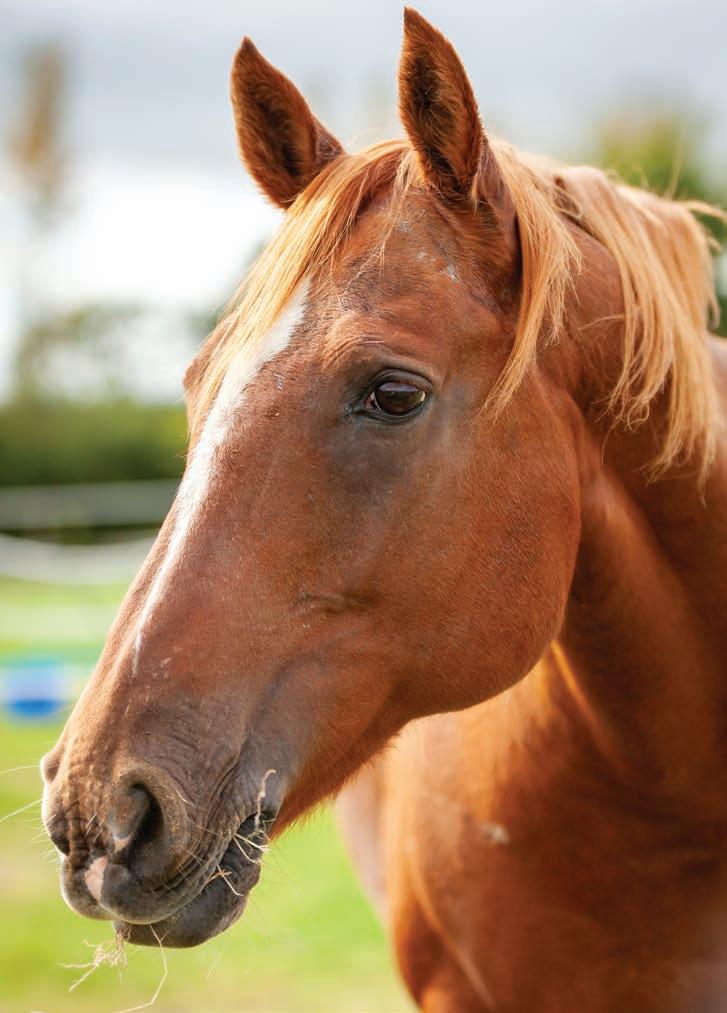
Week eight
The final week – 30km (two rides). I decided to travel again this week, so we headed to Rammerscales, as the weather was looking good. There are some great tracks on the estate and plenty of hill work too. I always enjoy riding over there. The astroturf tracks (for the dairy cows) are an unusual feature of this ride and some horses are a bit wary of it, but Flossy has been here many times, so no problem for her.
This section creates a lovely loop as an add on to the ride, so by the time I got back to the horsebox, I’d covered 23km and my speed was 10.2kph. Floss was feeling great and enjoying her work.
My second ride was just from home again – a swift 7km and we finished our final kms at 11.6kph.
This week’s polework was diagonal serpentines and the arrowhead. There were lots of
combinations you could use over these obstacles and I found Floss was enjoying the variety and it has definitely helped her over the last eight weeks.
The final TREC challenge was to reinback through a 4m channel between poles. I use reinback with Floss when I’m out, so she found this challenge easier than last week's.
The end
So we made it to the end of the Fit2Start Challenge and completed it successfully. Both Floss and I thoroughly enjoyed it, were much fitter and ready for the season ahead of us.
Many thanks to the SERC PR team for all their hard work putting this together and logging all of the data, and thanks to Robyn for all of the polework exercises. I've already started on my 2024 Fit2Start Challenge this year.
39 scottish endurance
Floss and I have started Fit2Start 2024
Floss enjoying some downtime
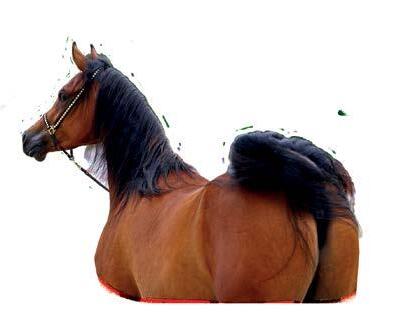




Arab Horse Society
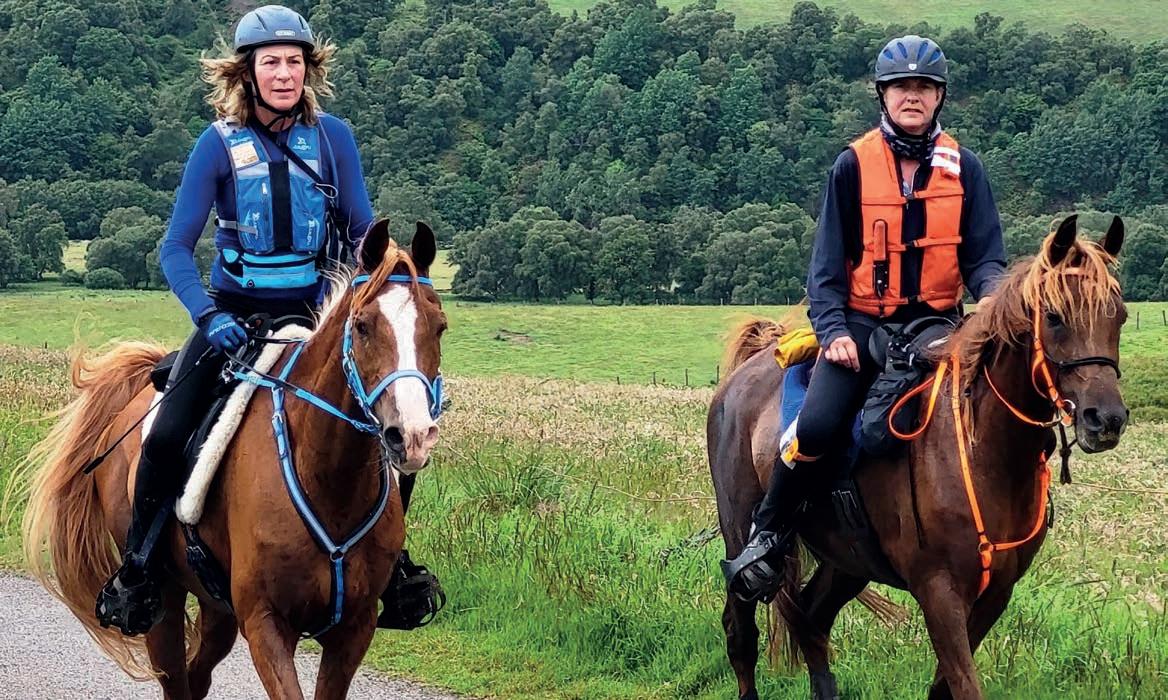

A breeder’s dream –the perfomance scheme
Anne Brown, Chairman of the Arab Horse Society's Premium Performance Scheme, explains what the scheme is all about
The Arab Horse Society (AHS) doesn’t like to blow its own trumpet, but – let's face it – a large proportion of successful endurance horses carry predominantly Arabian blood. In Britain, many descend from AHS Premium stallions.
Golden Horseshoe 80kms winner Mandarine, ridden by Kathy Carr, is by the AHS Premium racehorse Sambist, as is full brother Samba B, now qualified for FEI* races, ridden by Susan Hawes. Sarukh, another winner ridden by Susan, is a grandson of Imad, one of the most prolific Arab performance sires. Premium stallion Aurelian produced a host of front runners including Aurontes and Marcus Aurelius.
Kirsty Wiscombe’s part-Arab FEI*** Premium stallion Yawl Hillbillly has sired his own AHS Premium son Yawl Hill Big Yin, now pounding his way up the levels.
Esther Groen and her Premium stallion Watt du Colombier have won at 160km.
In Scotland, Seonaid Paterson keenly supports the Society’s Premium Performance Scheme (PPS), Tannasg winning the Scheme’s 2023 ‘Stud of the Year’ award in the Anglo/ part Arab section. Progeny from her pure Arab stallions, Psyches Boy and his son Tannasg Ansomrob, consistently place in rides and races.
The current list of more than 20 proven Premium performance stallions includes pure, Anglo and part-Arabs at public stud, either by natural covering or AI. So how do mare owners
tap into these proven bloodlines?
The AHS helps breeders through the Premium Performance Scheme: www.ahspremium.org.uk
The Society identifies successful stallions through the wo-day Stallion Performance Test, their ridden accomplishments, or ridden successes of their progeny – and grants them Premium status. The AHS then rewards mare owners when they use a Premium stallion and register the resulting foal.
To qualify for Premium status, an endurance mare must have completed a minimum 80km ride, or produced at least two offspring who have attained significant results in endurance or another ridden discipline.
Owners of Premium mares earn a Premium (currently £200) and free registration of the foal when they use a Premium stallion.
Premium stallion owners also have three ‘nominations’ a year, each which they may allocate to a visiting mare of any breeding but of suitable quality who hasn’t yet attained

Premium status. The resulting ‘nominated’ foal earns a Premium (currently £100) and free registration to help towards breeding costs.
These foals’ registration certificates will be over-stamped ‘Premium Progeny’ which opens doors to awards in endurance and other ridden disciplines. The AHS also awards rosettes to successful Premium youngstock in the annual Futurity Evaluations, organised by British Breeding. The endurance section produces a healthy number of Gold Premium winners.
Acceptance of stallions and mares onto the Scheme is at the discretion of the Premium Performance Scheme committee. Check if your mare could qualify at: ahs-premium.org.uk/. If she ticks all the boxes and you fancy breeding a Premium foal of your own, download the mare application form, select the best-suited Premium stallion and contact the owner from the list.
If your horse has Arab blood and is registered with the AHS in your name, he or she is eligible for endurance awards, especially if the horse is by an AHS Premium stallion.
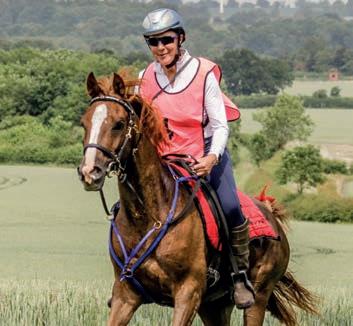
features Arab
Society
Horse
Sarukh and Susan Hawes
Mandarine by Sambist winning 50-miles class at Golden Horseshoe over Exmoor, May 2023
41
Arab geldings Tannasg Psyonny and Tannasg Solar Flare, both by PPS stallion Psyches Boy
Photos:
Iain Paterson, Anne Brown
Young riders
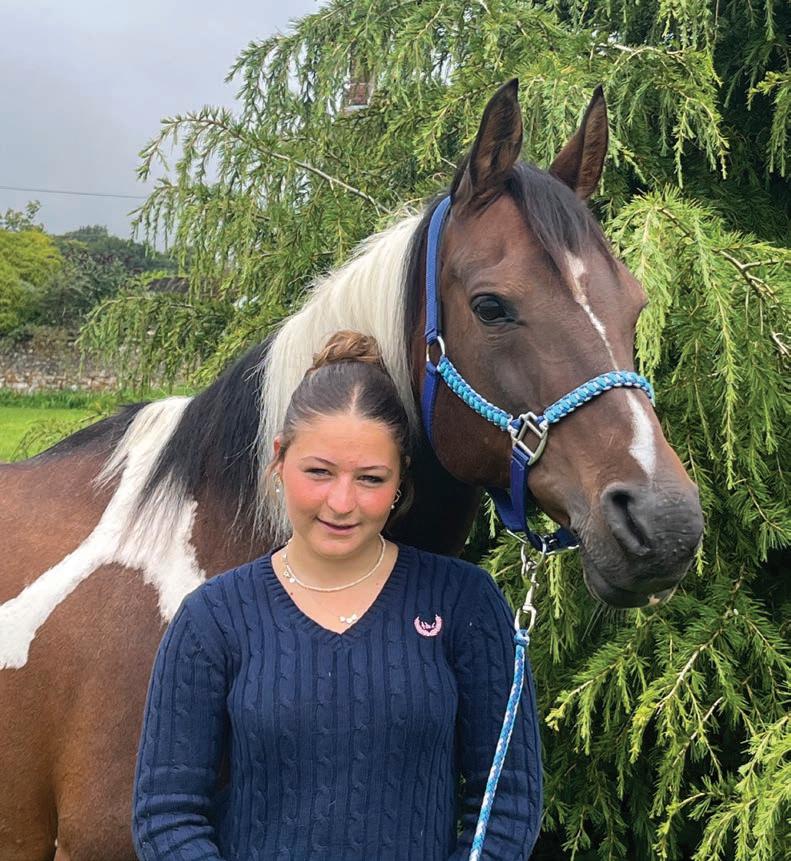
Young riders
We talk to Livvy Miller who, after her first endurance ride in early 2023, became hooked on the sport
Istarted riding when I was six and did mounted games and all things Pony Club related. I discovered endurance late in 2022 doing a couple of 32km rides with my Dad and was bitten by the bug! My crew consists of my mum and dad and it’s great having the family involved.
Both of my parents competed in endurance in the past and I jumped at the chance to try it myself. Early in 2023 my pony sadly was injured which

caused me to enter my first ride on my mum’s horse Ellie. However, this most definitely backfired on my parents as it sparked my love for endurance and the pair of us haven’t looked back since.
Ellie is an 15.1hh, Arab x Quarter Horse and has been part of our family since she was a foal. She’s now 15 so we have known each other almost my entire life. She is loving all the attention and work and has gone from strength to strength in 2023. We had a brilliant ride at Cirencester and qualified up to Advanced. We loved this ride and I am really looking forward to doing it again.
We went to Young Rider camp in the summer holidays and I met lots more great people who
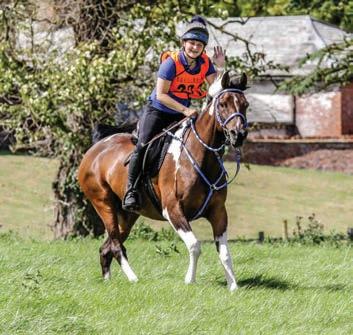

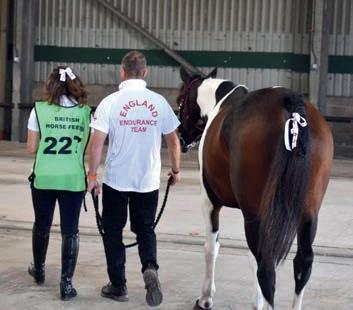
helped me get a better understanding with Ellie. This mare knows that she's the most important person she knows and also thinks she’s invincible, so she doesn’t always listen or make things easy for me. However, undoubtedly the advice and support provided to us from so many people has been incredible and very gratefully received.
Well Vale came around and we entered our first race ride, the Young Riders National Championships and Ellie found her element! It was an amazing day and we learnt so much and received so many prizes when we won.
The other major highlight from 2023 was riding at Red Dragon on the England team. It was a fantastic experience and I’m really keen to do this again. A huge thank you to the management and sponsors as we had a great time and had so much kit donated.
At the last ride of the season, I was able to bring out my new horse Khali and she did her first Novice ride, with Ellie taking her escorting duties with Mum very seriously. We had a lovely ride and we’re looking forward to seeing what the future holds for Khali as well as what Ellie and I can achieve.
The year 2024 is set to be a super exciting year as I have Ellie to compete as well as Khali to qualify. We have already been to a brilliant day with the development squad management and I am really looking forward to a busy season for the whole of ‘Miller Endurance’.
young riders features | endurancegb.co.uk
Livvy and Ellie at the Tilford Ride
Livvy's now hooked on endurance
Livvy with her dad and Ellie
Livvy aged three with Ellie
Photo: IndiePics
42
Photo: LRG Photography



Don’t put your horse at risk! Always use a Registered Farrier It is illegal in Great Britain to practise farriery if unregistered. Check the Register at www.farrier-reg.gov.uk frc@farrier-reg.gov.uk 01733 319911 Farriers Registration Council Contact us for a quote 0345 230 2323 kbis.co.uk Why choose KBIS Horse insurance? • As many as 13 different Vet Fee options to choose from* • Up to £6,000 per incident* • 15 months cover from the onset of an incident • Full Vet Fee cover up to and including 25 years of age • Standalone Vet Fee options including our unique Catastrophe Cover available for less than £500** *Age, use and value dependent. **Price quoted is for standalone Vet Fee cover, other cover benefits will incur an additional premium. KBIS Limited is authorised and regulated by the Financial Conduct Authority (FRN:300861). Registered Address: 6th Floor, One America Square, 17 Crosswall, London, EC3N 2LB. Registered in England and Wales. (Company No. 02208091). KBIS Limited is part of the Specialist Risk Group.
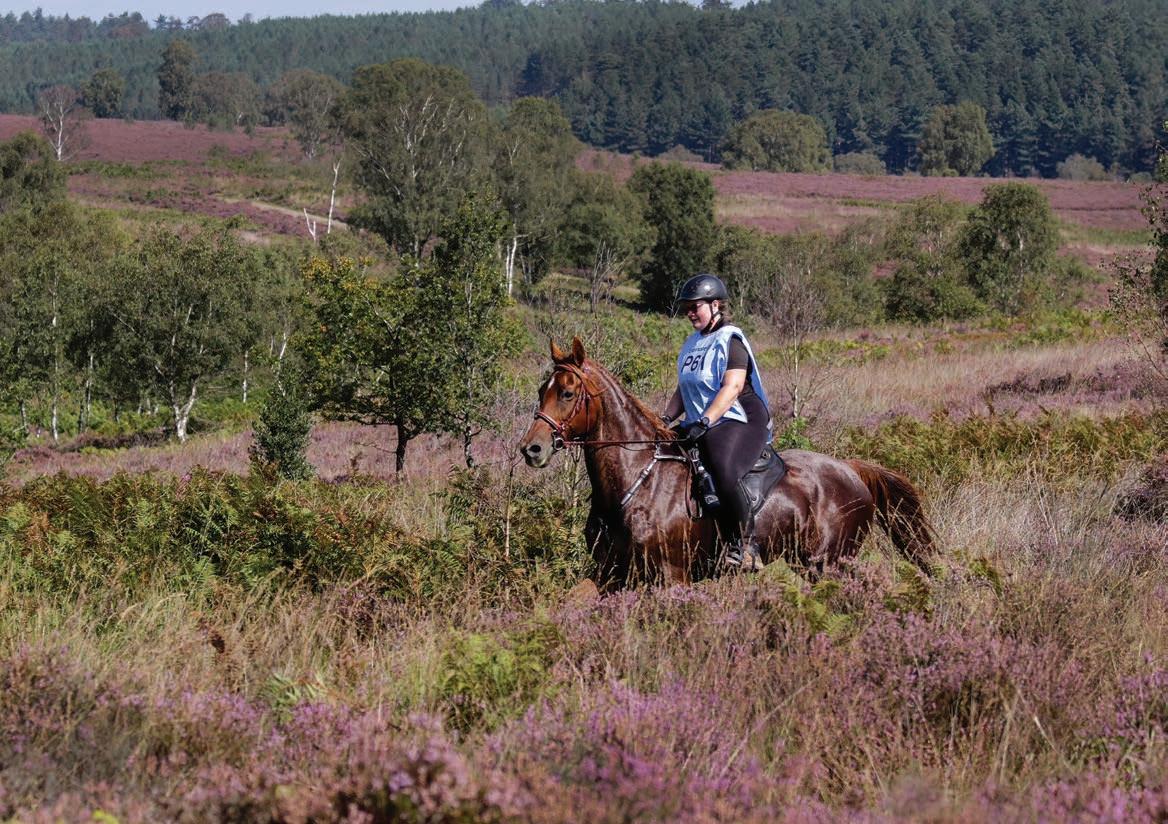
Read on to meet the two new Para ambassadors, find out what happened at the November 2023 training day and discover dates for your 2024 diary
IIn 2022 Endurance GB created the Para Ambassadors' programme offering talented Para endurance riders at all levels the chance to apply for individual support and training. The 2022/2023 cohort of Para Ambassadors formed a group which (despite a wide diversity of age, needs and competitive experience) has been supportive of each other’s challenges and has contributed actively to discussions about the future direction of Para Endurance as a discipline.
There were some notable successes competitively from this group. Overall, the initial programme has been a positive experience in terms of athlete development.
Endurance GB is therefore delighted to announce that the generous financial support of the Saddlers’ Company has enabled us to continue the Para Ambassador programme into 2024. We’re thrilled to introduce our two new Para Endurance Ambassadors – Eleanor Vinnicombe and Sabrina Stell. We wish them the best of luck for the coming season and look forward to watching their progress.
Eleanor Vinnicombe
I’m Eleanor, a Para young rider, currently in my second year at Harper Adams University
Para endurance
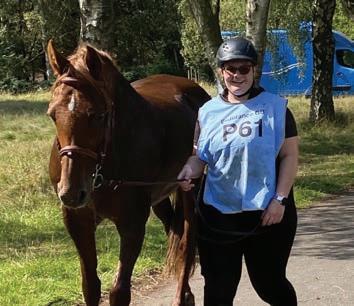
studying veterinary physiotherapy. Some of you may know me from when I rode with the wonderful Jane Greatorex, who took me under her knowledgeable wing and showed me what endurance was all about.
I sort of fell off the endurance radar two years ago, only a few months after completing my first FEI 1* on Jane’s incredible horse Rusty, when I became ill. After a lot of uncertainty, I was eventually diagnosed with functional neurological disorder among other things and told I may never properly recover. At that point life was just about getting through each day and passing my A-levels to get into uni. Horses became a nice hobby but I accepted I probably wouldn’t compete to the same level again or achieve any of my previous goals.
About a year later, and a few months into my degree, I started to think seriously about horses again and became aware how much of me was missing without them. I rode a bit but nothing’s the same as that real bond with your horse and I missed the liberty work I used to do. So, after a lot of thought, I began my search for a horse! I also missed the endurance community as everyone’s so friendly and supportive and it’s so lovely just to chat with different people while riding along.
In August this year along came Sherpa, a part-bred Arab bred by the Druimghigha Stud.
Although life will probably never be the same as it was before, I feel I’ve grown a tremendous amount over the past few years and just being around horses again everyday, as I’m sure many of you appreciate, makes the world of difference. Sherpa and I did a couple of rides together last year and hopefully we’ll upgrade her to Open and Advanced this coming season. However, my mindset around rides has shifted and I just want to enjoy getting out with my horse as part of the endurance community, something that a couple of years ago I didn’t think would be possible again.
Although riding and life in general is harder for me now after getting ill, the happiest memories I have are cantering through King's Forest, so I’m pushing myself hard to be able to compete and work with horses because I refuse to let living with a disability stop me from doing what I love.
regulars | endurancegb.co.uk para news
Para news
Eleanor Vinnicombe and Sherpa
44
Photo: IndiePics
Sabrina Stell
I started my endurance journey in 2018 in a bid to rekindle my passion for riding. My health had deteriorated to a point I was no longer safe to jump and that was all Loki and I had known competitively.
I was born with Ehlers Danlos Syndrome and have developed various co-morbidities over the years. We were both very down and felt like we had no place in the equestrian world anymore. I owe everything to one of my best friends Lucy, who not only introduced me to endurance that year, but helped me prepare Loki, figure out my health constraints and told me there was a Para rider section I could apply for.
By 2022 we had an amazing Novice season, winning Southwest Novice of the year and achieving our Para Gold distance award, second in the Amythyst award and third in the Sapphire.
In 2023 we’d already achieved all our goals and more, so I decided that I'd like to give Open level a go. I knew the higher speeds would be a challenge for my body, but I’d been given a breadcrumb to follow.
In 2023 we won our class at Red Dragon (this was a particularly challenging ride physically for me), achieved our 400km award and then, while I was celebrating a successful Open season, I found out that we’d won the Para Society of Master Saddlers award, again achieved our Gold distance and finished reserve champion in the Amythyst award!
The day they arrived, I sent photos to my parents before telling anyone else. They have found my deterioration hard after struggling for years to find a diagnosis, so I love showing them I’m not letting my health hold me back.

Junior/YR/Para training day
Eight riders attended this day at Stretcholt Equestrian Centre, Somerset on 4 November. Expert coaching was provided by Level 4 coaches Cindy Russell and Clare Turner in the beautiful indoor arena.
Having assessed the riders in the morning with some flatwork, the participants were encouraged to let their hair down and have fun with barrel racing in the afternoon. With mounted groups
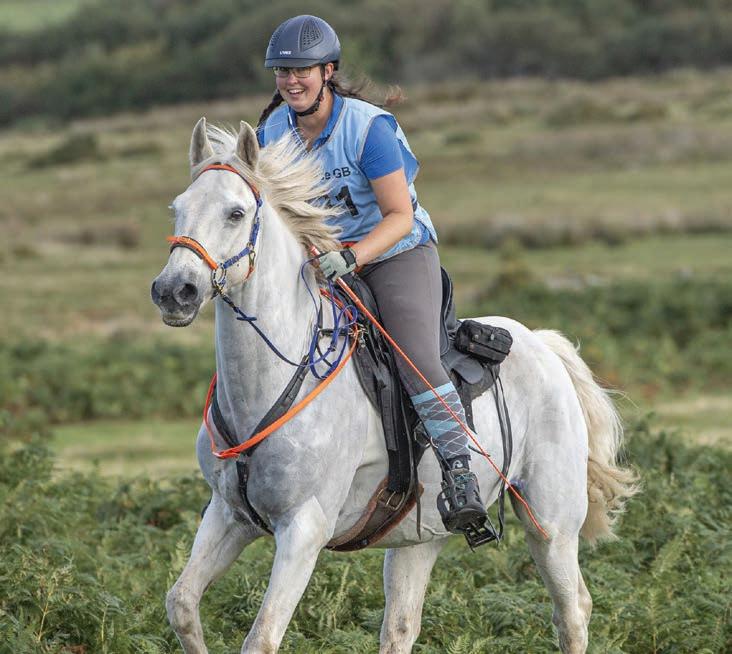
Where do I go from here? Well, I’ve already achieved more than I thought I’d be able to, so I’ll keep setting myself goals and keep reaching.
In 2024 I plan to introduce Buckley to his first season. It’ll be a short season as he’s still young, but he’s showing great potential.
Training my own Para horse has been so rewarding. Loki is amazing at looking after me, so expectations were high. I’m sure they have an understanding now Loki has accepted he has to share me!
Buckley’s yet to experience me having a dislocation or subluxation in the saddle, but we’ve prepared well for this. When you
alternating with unmounted, they were fortunate to have additional expertise on the ground.
International YR team physio Holly Stuart attended in the morning, sharing some of her knowledge with the assistance of demo ponies. Clive Whereatt, Master Saddler, joined in the afternoon, giving an excellent general demo as well as having a look at individuals’ saddles.
During the lunch break, participants were treated to an informative and inspirational talk by international vet Kieran O’Brien.
Thank you to the Saddlers’ Company for contributing so much funding to this day.
All dates are open to Young/Junior Riders and Para Riders and their escorts and are kindly sponsored by the Saddlers’ Company.
• Saturday 23 March: Mounted training day at Selston EC, Hill Bank Farm, Commonside, Selston, Notts, NG16 6FJ
• 30 July–2 August: Camp, kindly hosted by Olwen Law at Reeside Farm, Neen Savage, Shropshire DY14 8ES
Location and date of further mounted training day later in the season TBC.
consider how much a horse has to learn in general and then add in everything from being led with crutches or even a chair, throwing weird shapes in the saddle or even staying calm when I’m not, I ask a lot of my horses.
I’d like to take Loki to the National Championships. I know this is an almost impossible task but I remember when 40km and completing Red Dragon felt like that. I tell people, reach for the stars and you might touch the moon and now it’s my turn to listen to that advice. The good thing about Para Endurance is it gives me the opportunity to keep trying to reach the stars.
2024 Dates for your diary
Please note camp date has altered due to a clash with the changed Home International. It will now run 30 July-2 August.
Para Endurance Competitions 2024
Regional Championships will have a Best Para Award kindly donated by the Saddlers' Company. The dates/locations for these rides confirmed so far are…
• Pembrey – hosting the Welsh Championships 20-21 April 2024
• Dialstone – Hosting the Northern Championships 26 May.
Para Equestrian National Endurance Championships
Generously sponsored once again by Livery Live, they will be hosted by The Lion’s Tail on 14-15 September. Championship classes will be offered at all four levels - Emerald, Sapphire, Amythyst and Onyx.
para news
45
Physio Holly sharing her knowledge
Sabrina Stell and Loki are reaching for the stars
Photo: Rachael Claridge
Photo: Farlap Media

From the horse’s mouth
so I had time to find out about the participants, especially those who owned or rode horses.
Getting started
Iread with interest the posts in the Friday Firsts series on the Endurance GB Facebook page from last year and it prompted me to reflect on my first experience of an organised ride in 1995.
I had acquired Carn from a friend/work colleague who had bred him but whose circumstances had changed, meaning he needed to be rehomed. Carn was a 14.1hh part-bred Welsh Section D.
Carn was two when I got him. He was started as a three-year-old and everything was done gradually by the book. In 1995 – when he was a fairly mature five-year-old – I worked in Local Government as a Training Officer. In those days lunch was an integral part of training sessions

One day an individual showed me an A4 sheet of paper advertising a ‘Social Ride’ organised by the Offa’s Dyke Group of the Endurance Horse and Pony Society. The ride was to be held in the Black Mountains near Abergavenny.
To enter, all I had to do was fill in my name, contact details, horse’s name and age and send it to the Organiser with an SAE and a cheque (remember those?). It was probably £5 to enter.
Anyway, shortly before the ride date I received a map, a talk round and relevant information.
I was so excited. Another friend/work colleague arranged for me to ride with a more experienced person. So, having tacked up and mounted, off we went on our 10-mile adventure. It was simply brilliant! The route was well marked, the going fantastic and the views stunning. Carn also thought it was great and I got a rosette – a black and yellow one.
Everyone involved with the ride was really friendly and I was hooked. I had been sort of interested in finding out about endurance but hadn’t known where to start – the rest is history.
I kept in touch with the lovely people I met at that ride who passed helpful information and nannied me on some of my first rides. I did some more Social Rides, then National Pleasure Rides where we were vetted – all good experience for when I participated in Competitive Trail

Rides (CTRs), which were succeeded by Graded Endurance Rides (GERs). Many people I met then are still either competing or are regular attendees at Group Rides (as am I). The Black Mountains Ride still is held occasionally.
Word of mouth
I became disillusioned with Local Government and qualified as a driving instructor in 2005. The learner driving business thrives on word of mouth recommendations. I’m sure you will have – like me – passed on details of your farrier, vet, saddler, rug cleaner, and so on. Word of mouth is a very powerful method of recommendation.
So imagine if all Endurance GB members recruited one new member. We could double the membership – how good would that be?
Sadly, it’s unlikely to happen, but along with social media when we’re at our feedstore or tack shop (or out hacking) wouldn’t it be a good opportunity to talk to those we meet – ask them about their equine activities but tell them about the different aspects of endurance and the chance to experience beautiful countryside and make new friends. Exchange contact details, keep in touch, arrange to meet up to ride. There are lots of opportunities to encourage some new recruits – all through word of mouth.
Years of fun
Carn was never my main mount but I remain eternally grateful for him assisting me on my endurance journey. He had some minor successes in his career. These include…
• Sixth in his Tyro Endurance Ride
• Tenth at a very hot Cirencester 80km
Endurance Ride with more than 20 starters
• Always placed in Performance Formula classes when they were add ons
• Won the Napoleon Cup at Red Dragon
• Sixth National Veteran at 18
• Completed Man Versus Horse three times coming third then fourth twice
• Completing 3,200km of which over 1,600km were Grade 1s.
All these achievements came from an introduction by word of mouth and Carn lived until he was 31, passing away in 2021.
word of mouth features | endurancegb.co.uk
Hilary Cuming discusses the importance of word of mouth and how it started her own journey into the endurance world
Word of mouth
Competing at Ludlow
Hilary and Carn at Cirencester
46
Photos: West End Photography, Eric Jones
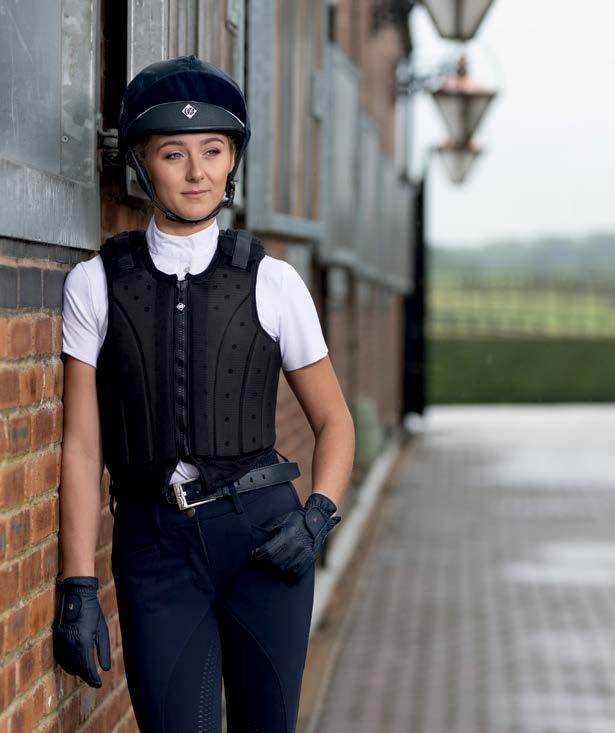
Charles Owen

Kontor, Charles Owen’s latest addition to the world of equestrian safety wear!
Certified to EN 13158:2018 & BETA 2018 standard level 3.
RRP from £160.
at www.charlesowen.com/kontor

Find
more
out
Introducing AVAILABLE
World Champion Yasmin Ingham wearing Kontor by
KONTOR
NOW

High Quality, crafted forage feeds, grown with care in the UK.




Check out our website for the full range of natural grass and alfalfa feeds



’It may look very simple, but it certainly keeps my livery of 30 horses, healthy and in fabulous condition’. Helena Charlesworth, Herefordshire.

 Sian Broderick Photography
Sian Broderick Photography







 Nicky Moffatt | Editor of Endurance Magazine
Nicky Moffatt | Editor of Endurance Magazine





















































 Competition winner
Welsh Section D Lynbrie Rhys, aka Oscar
Shetlands Joshua and Otis
Jon measuring Oscar's heart rate
Competition winner
Welsh Section D Lynbrie Rhys, aka Oscar
Shetlands Joshua and Otis
Jon measuring Oscar's heart rate



























 Amanda Hamley More Salutes and Hayley Gilmore Art Mauresque at The Red Dragon start
A retrained racehorse can learn to stand still and be vetted as well as any other horse
Amanda Hamley More Salutes and Hayley Gilmore Art Mauresque at The Red Dragon start
A retrained racehorse can learn to stand still and be vetted as well as any other horse










































































 Sian Broderick Photography
Sian Broderick Photography